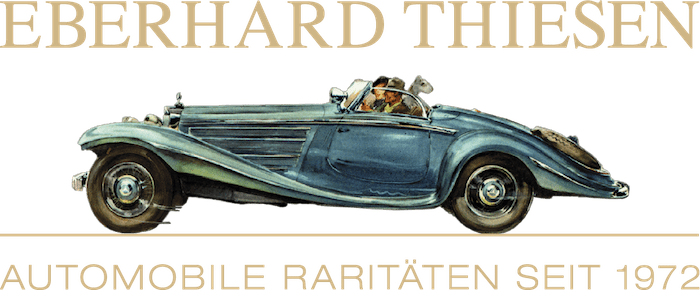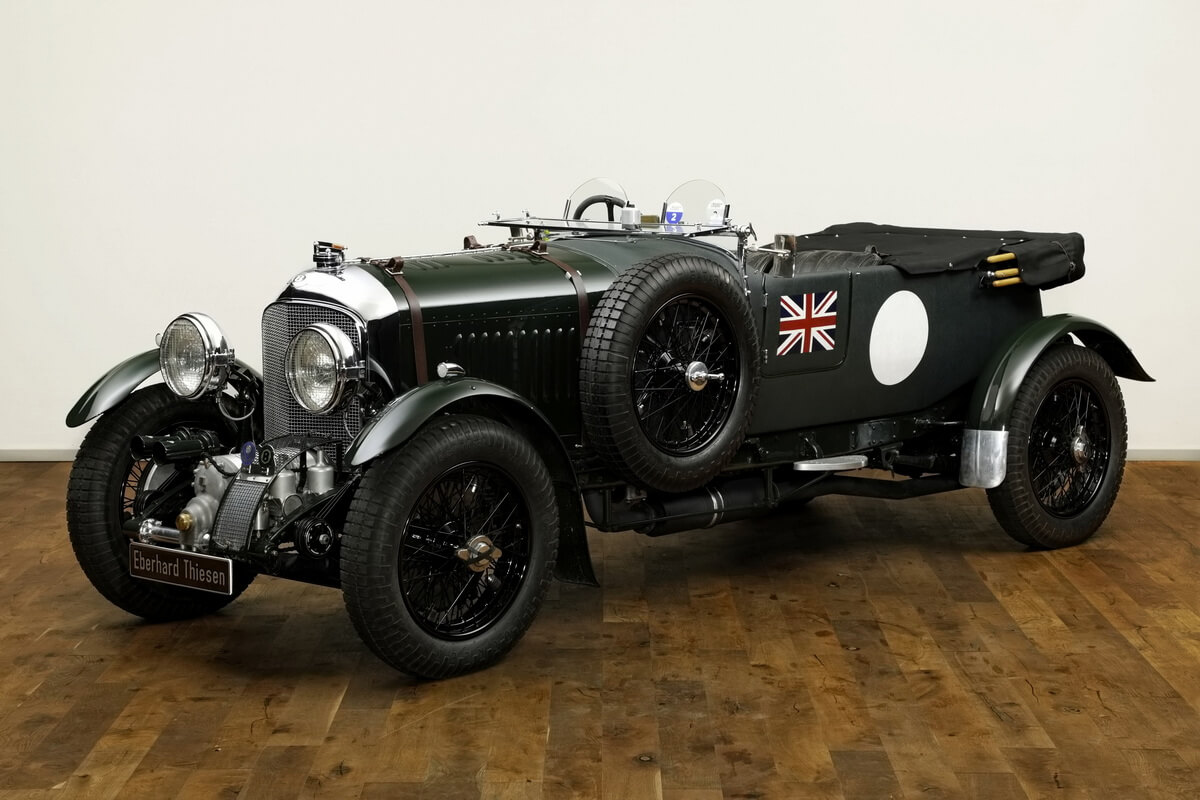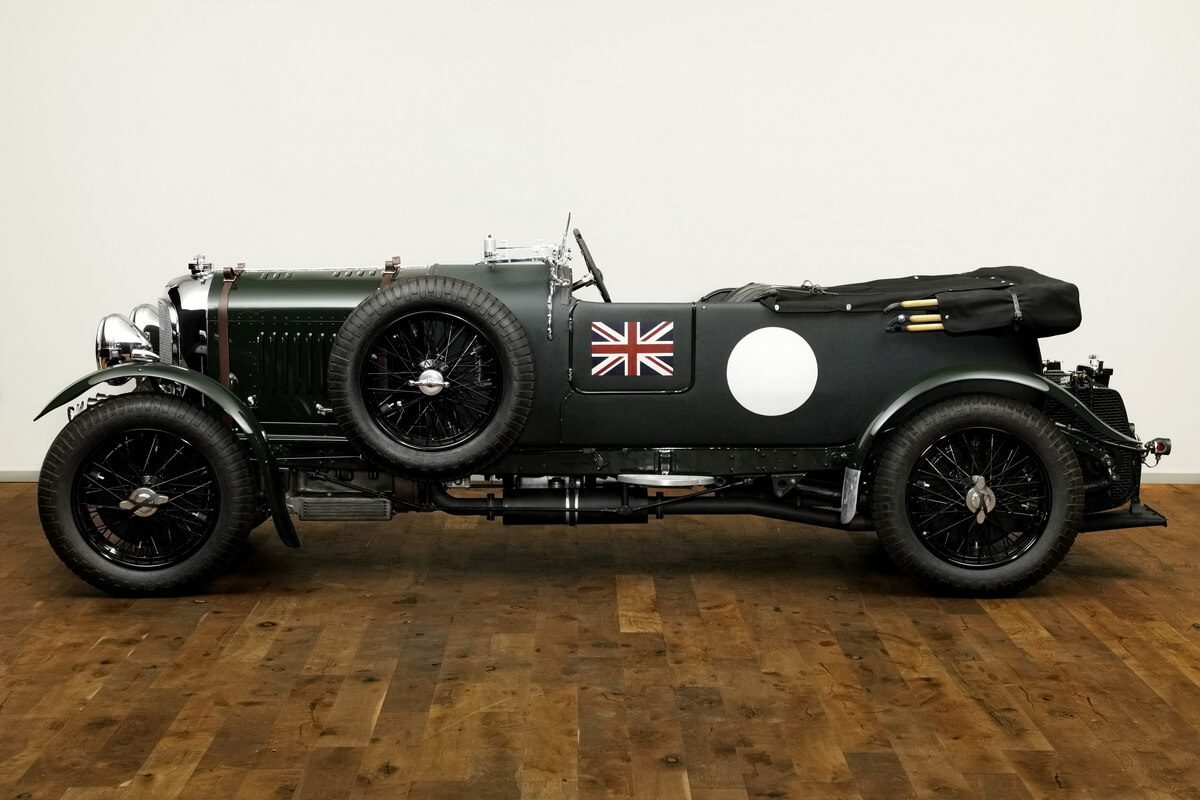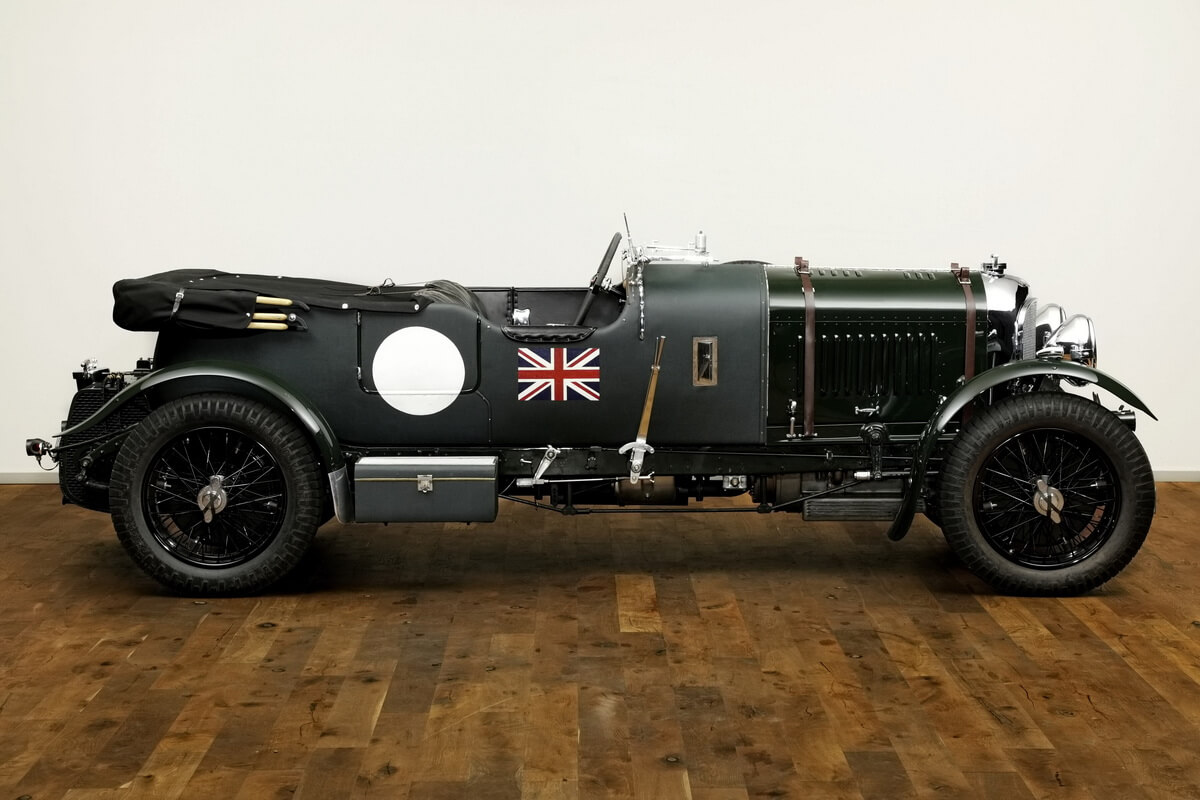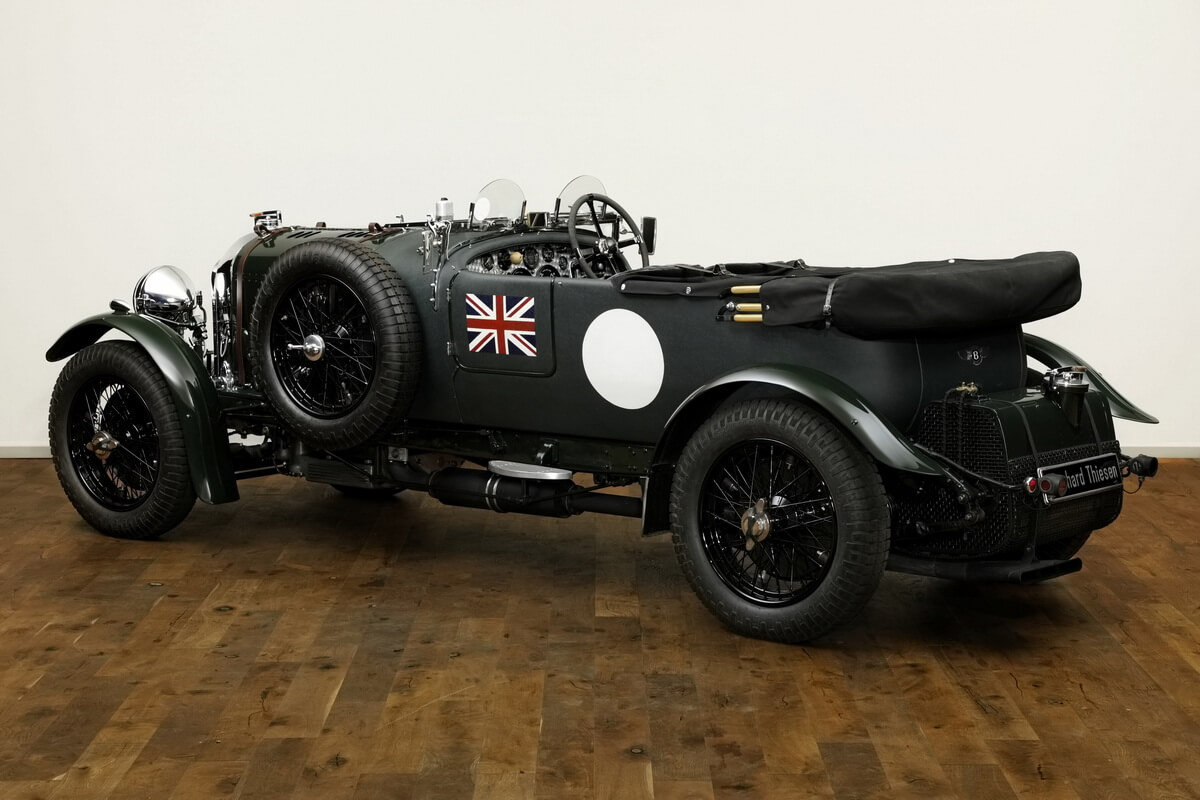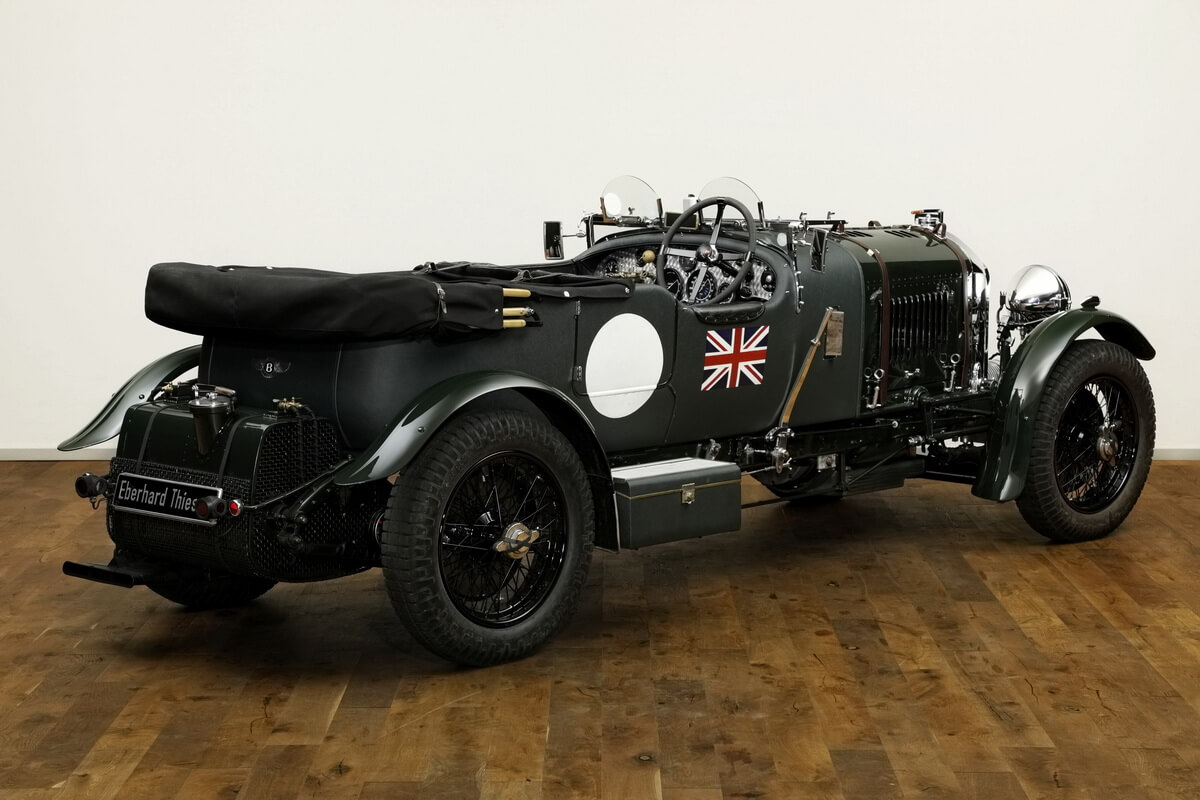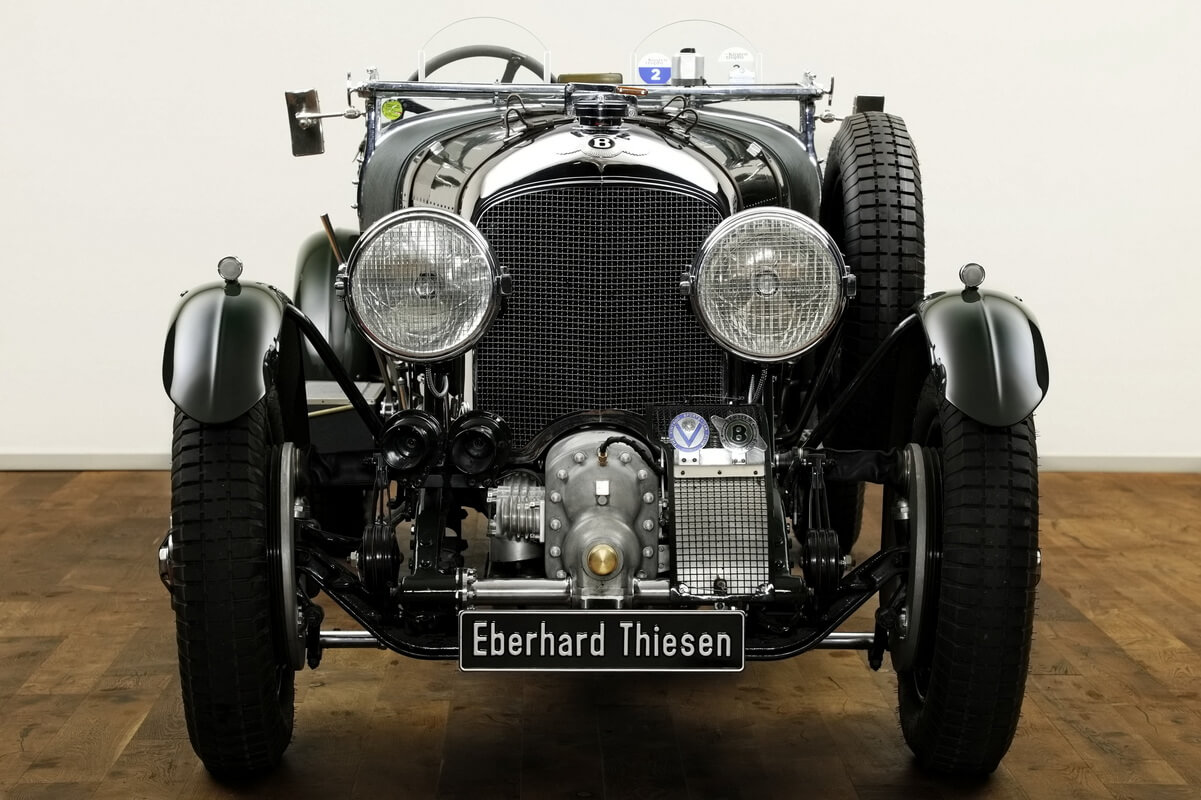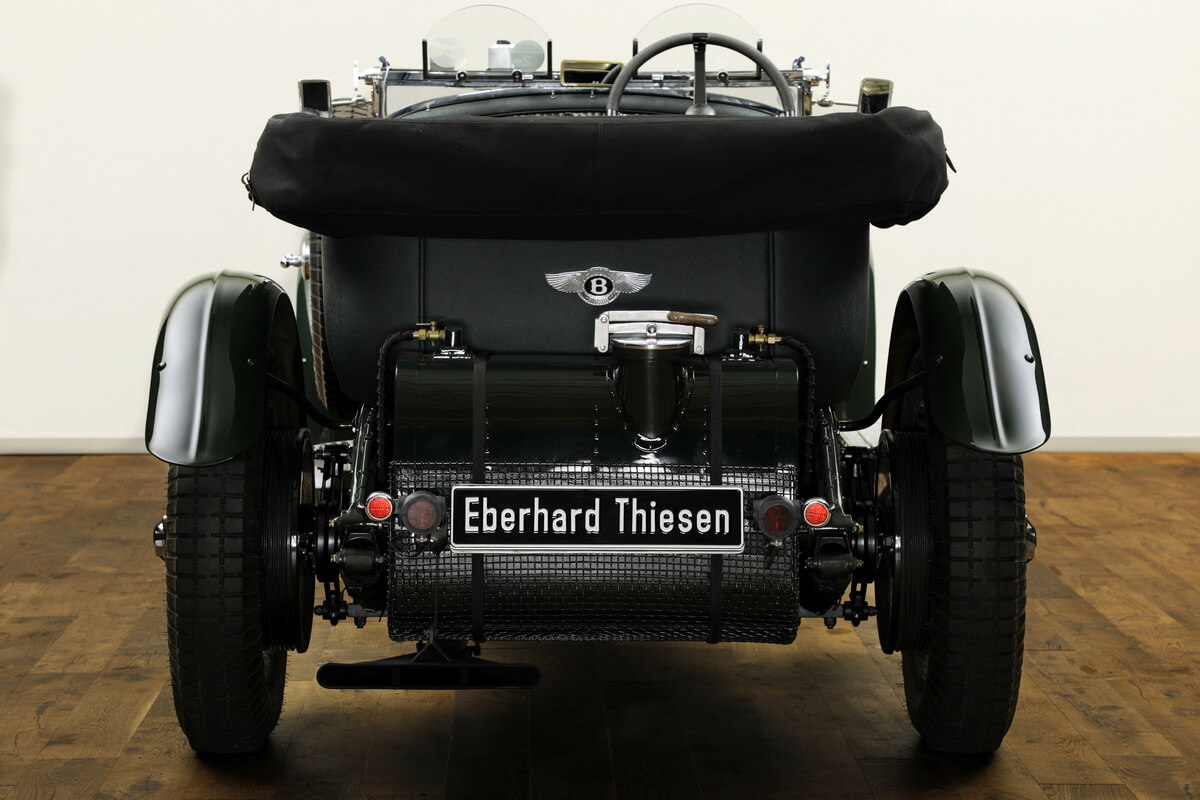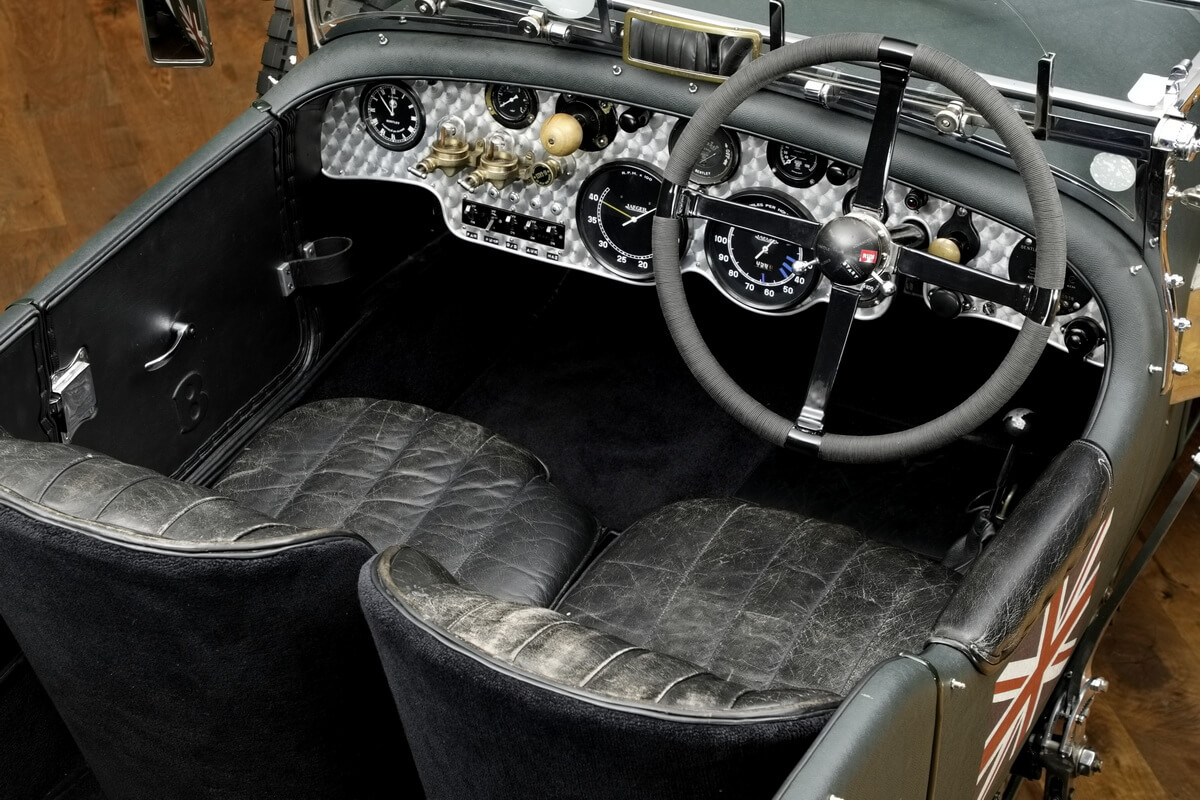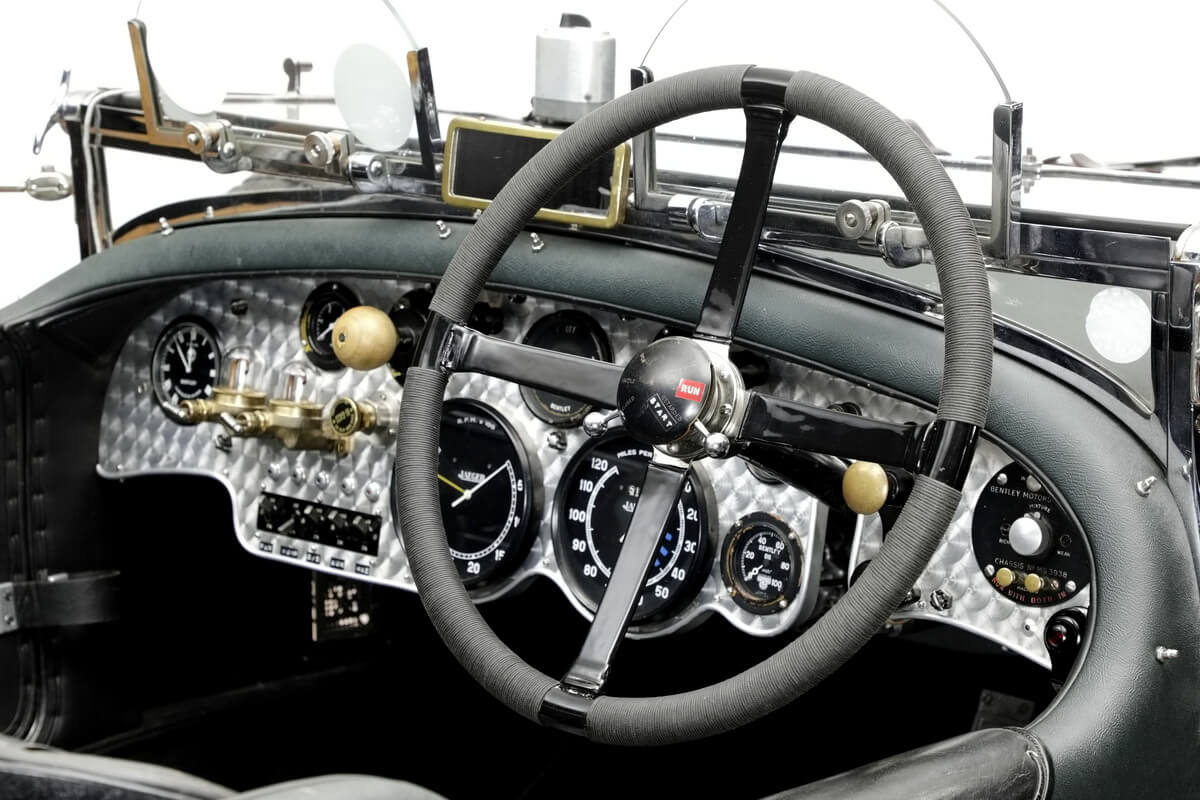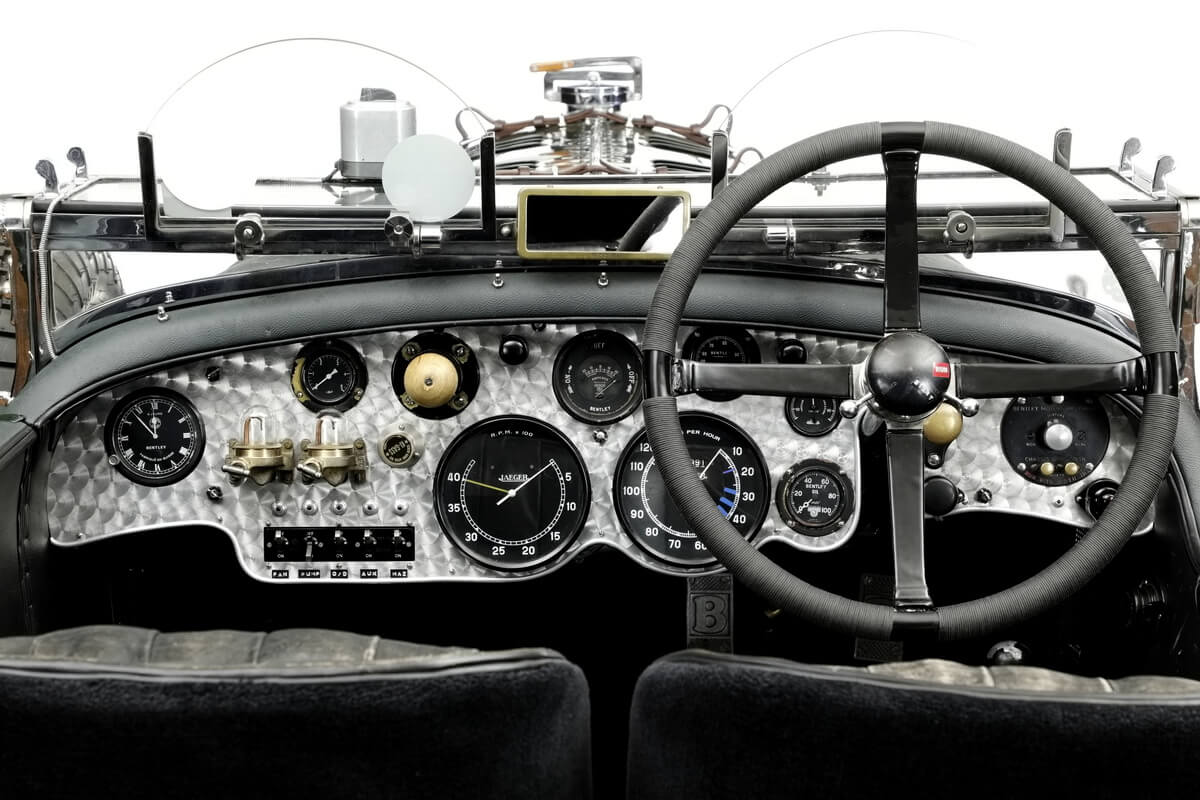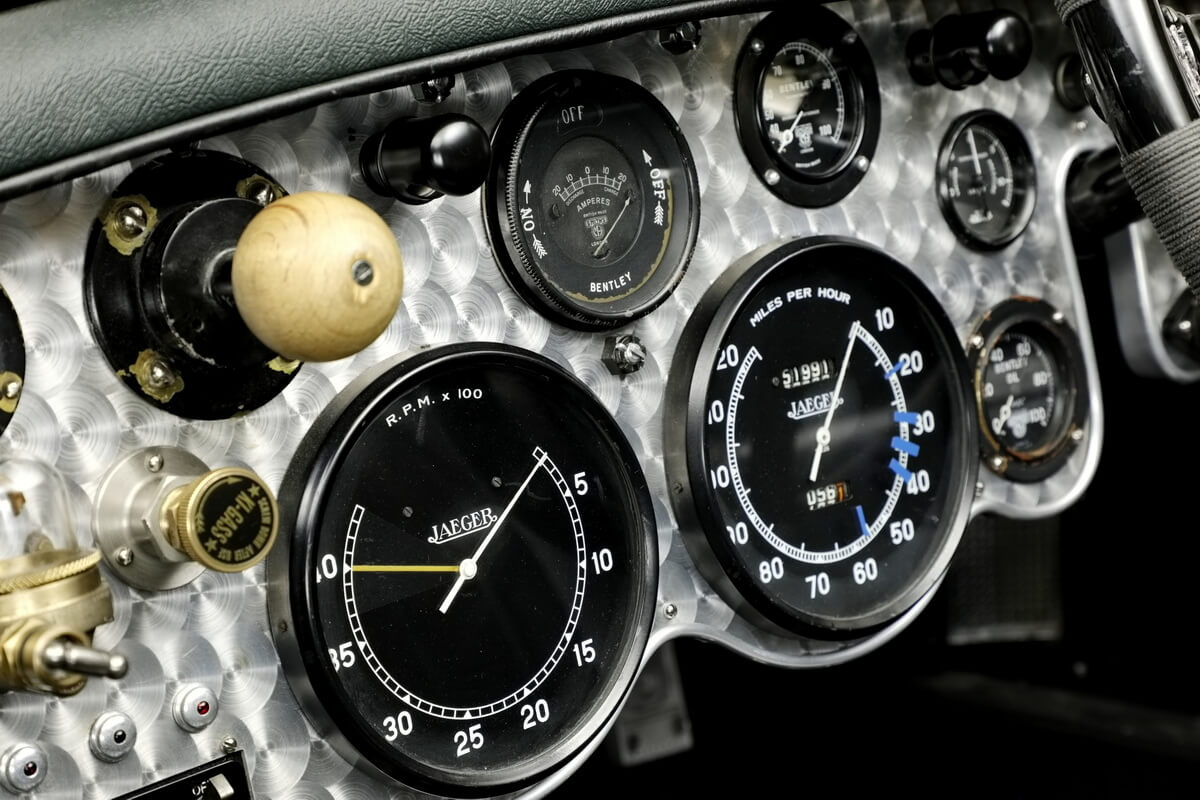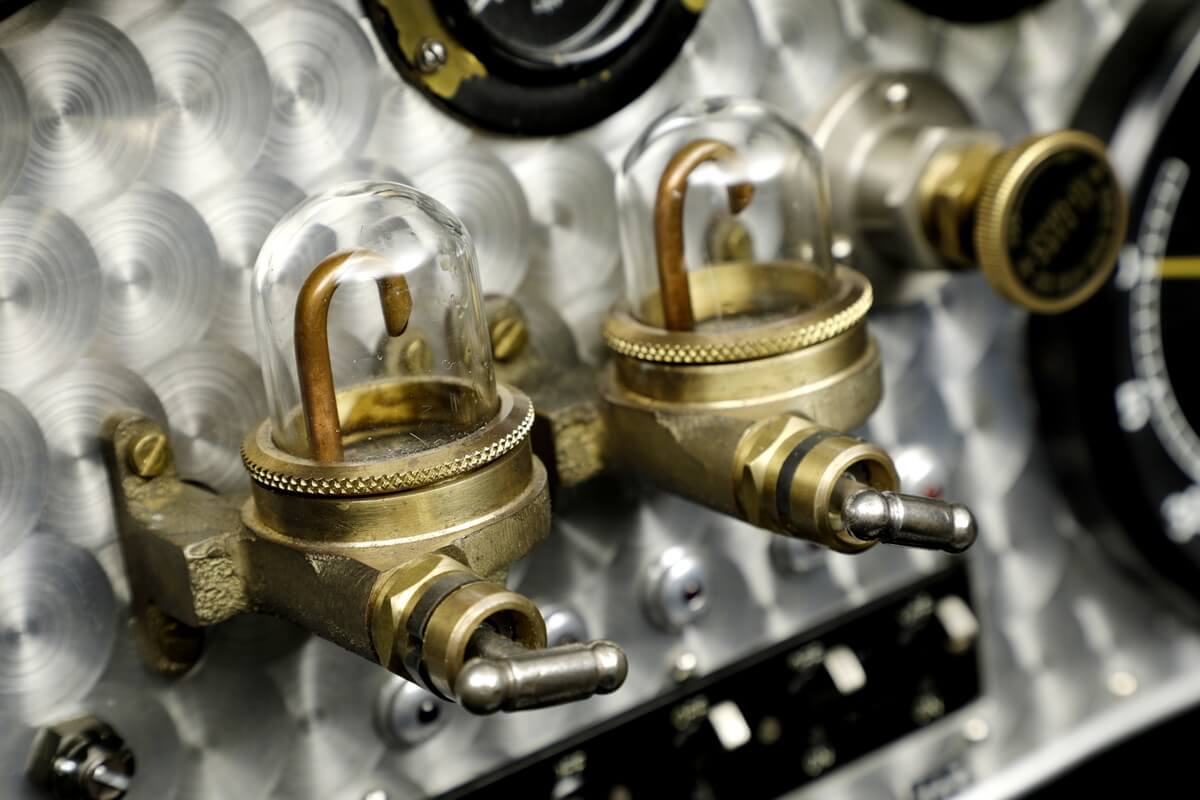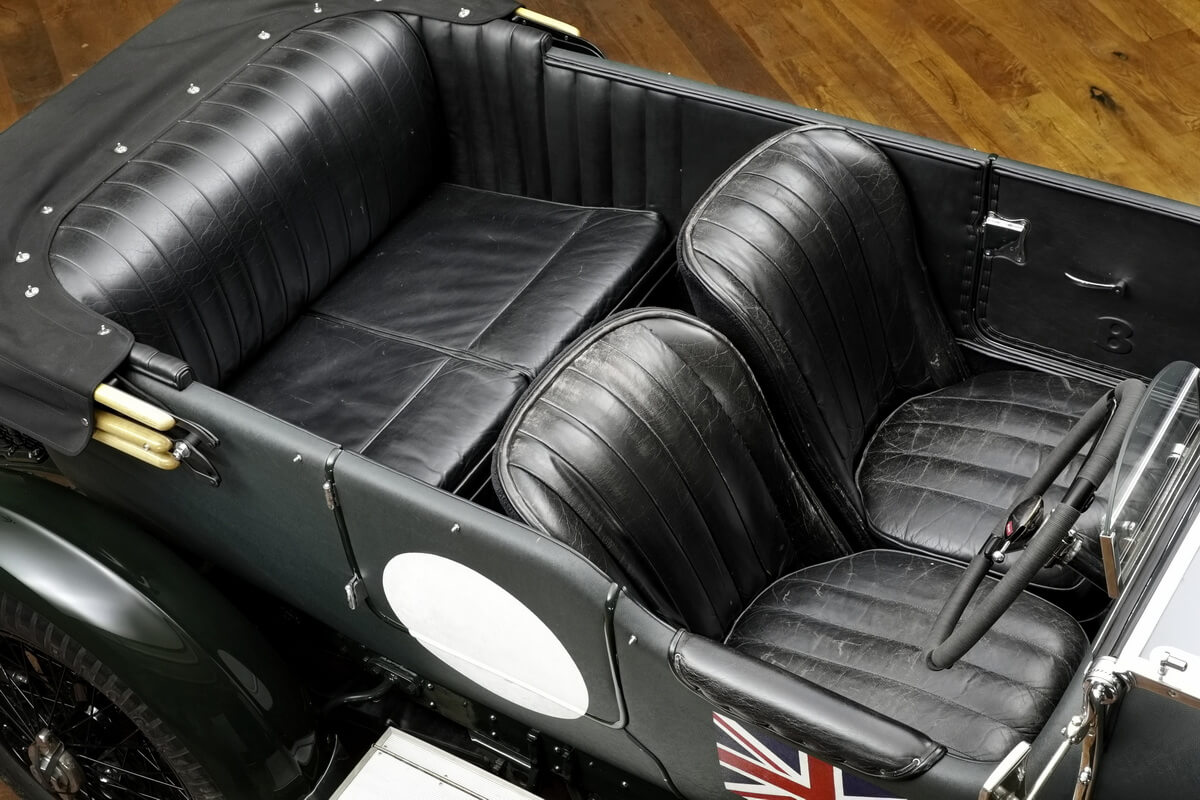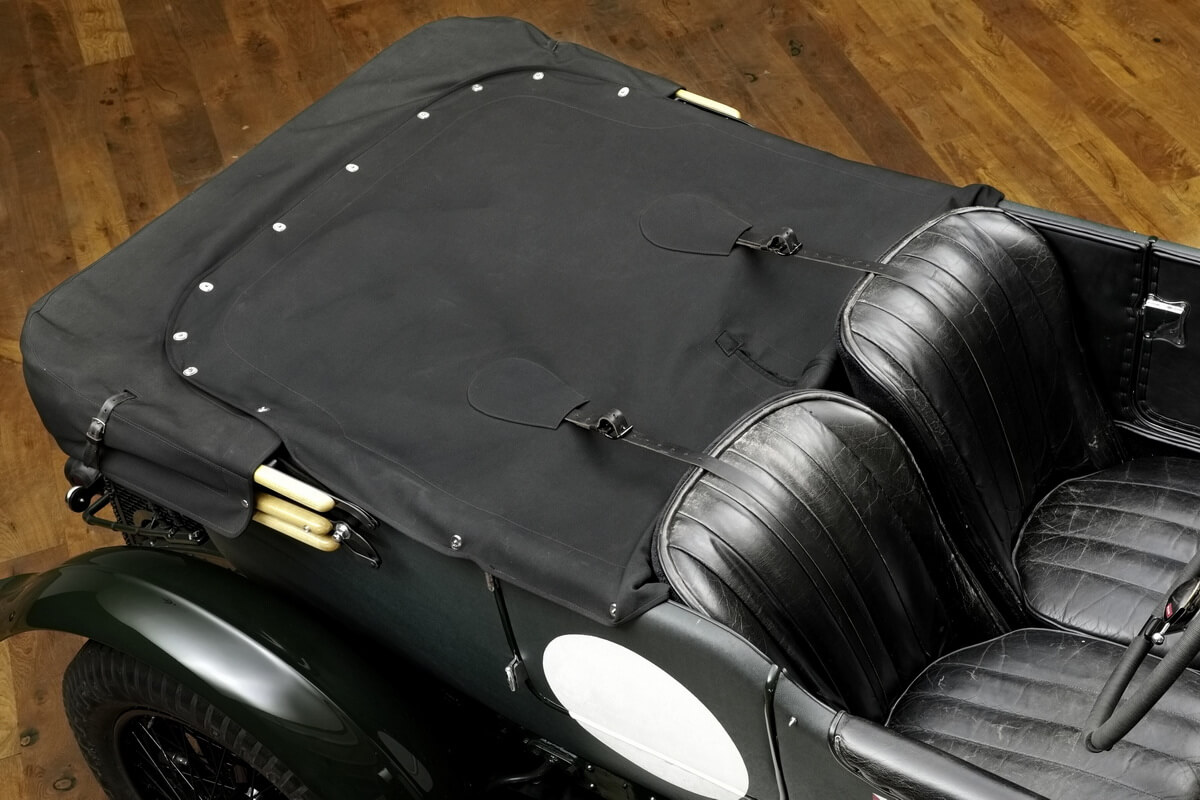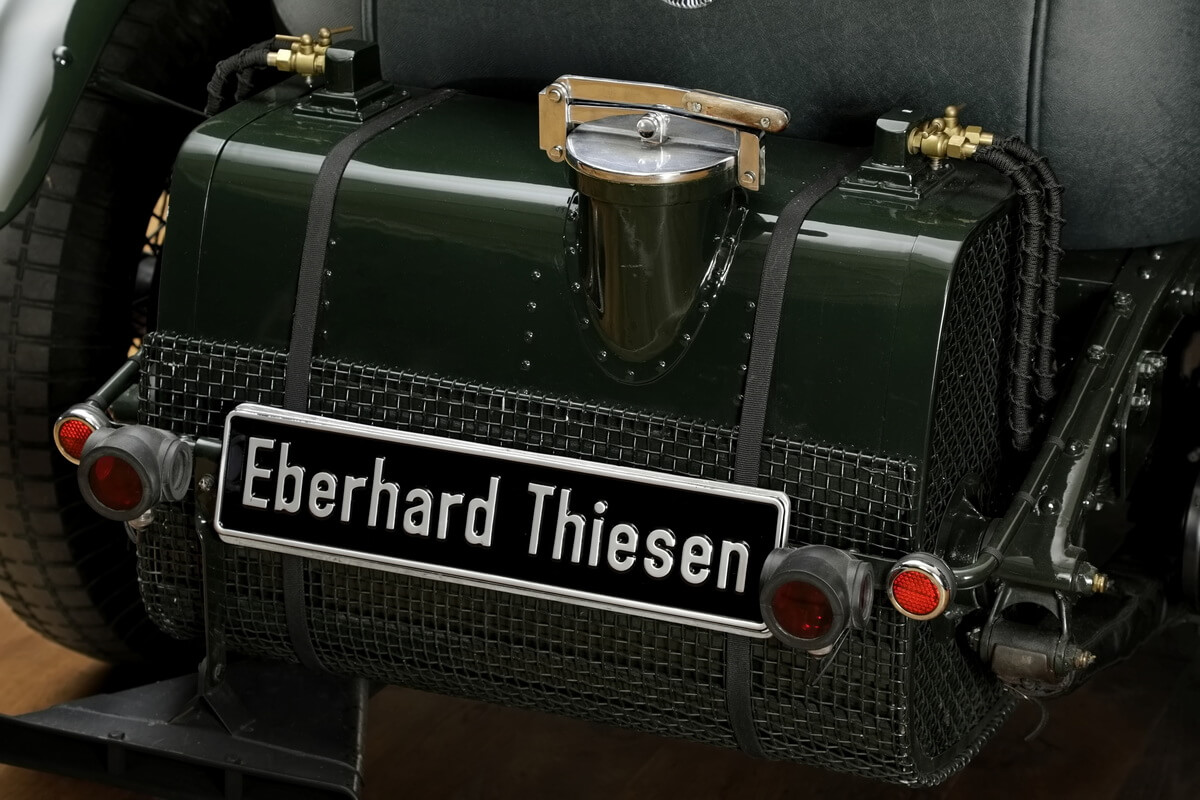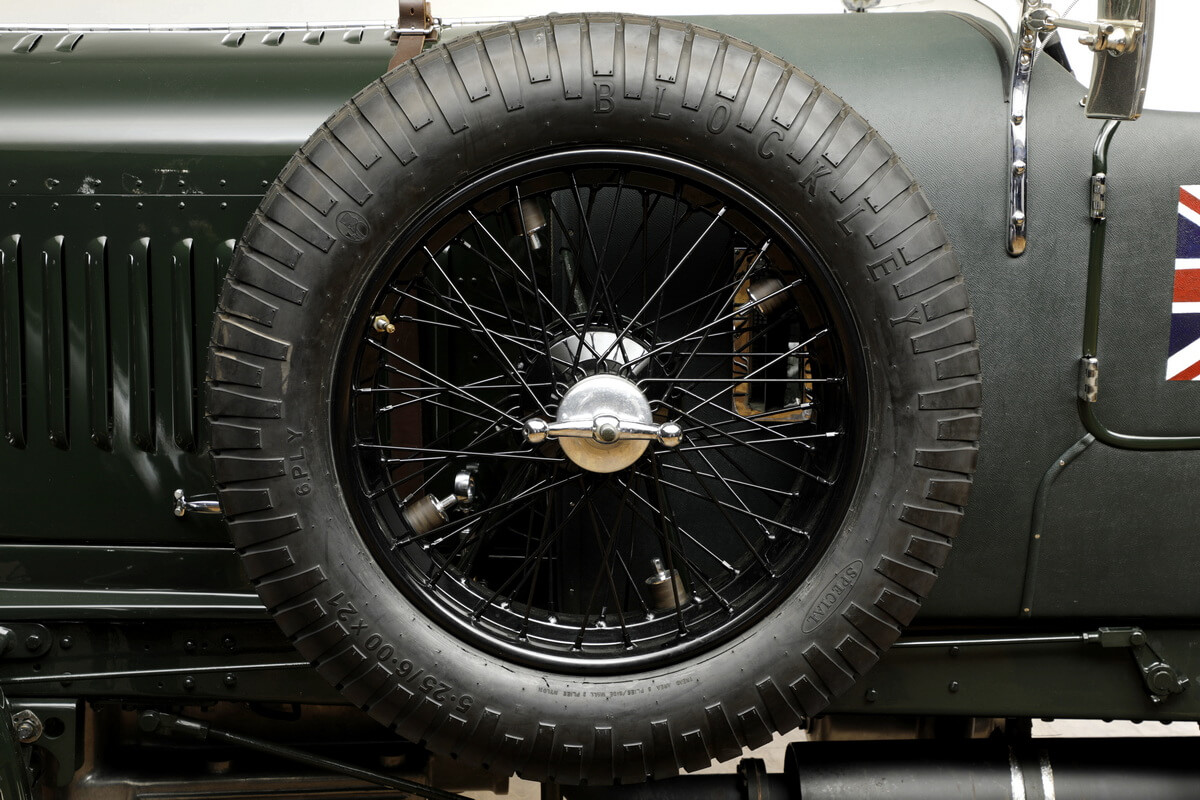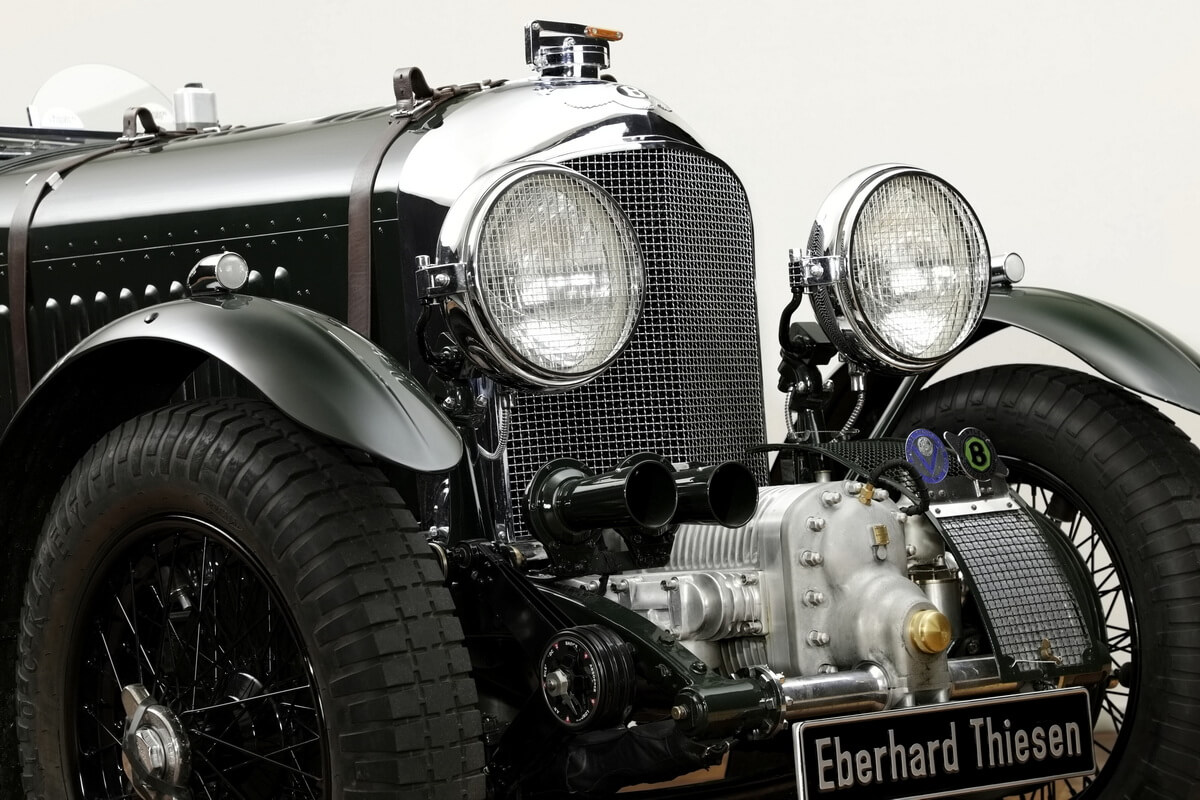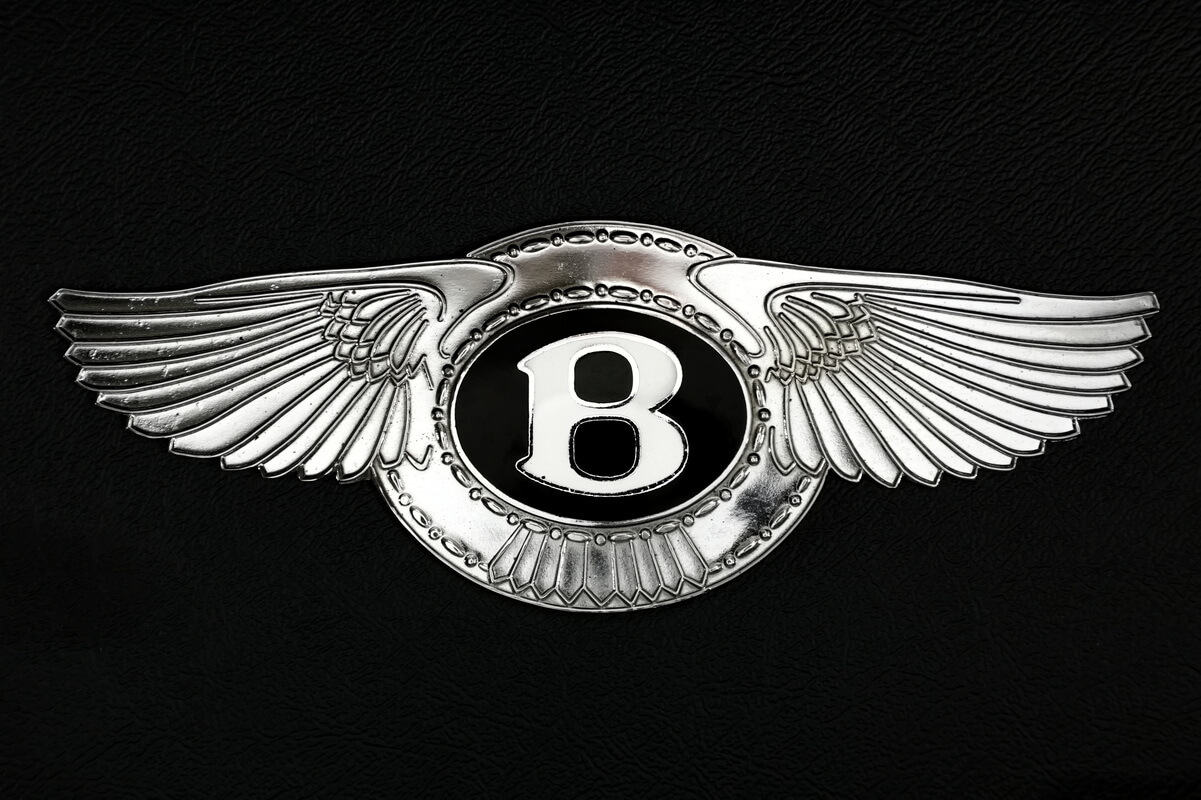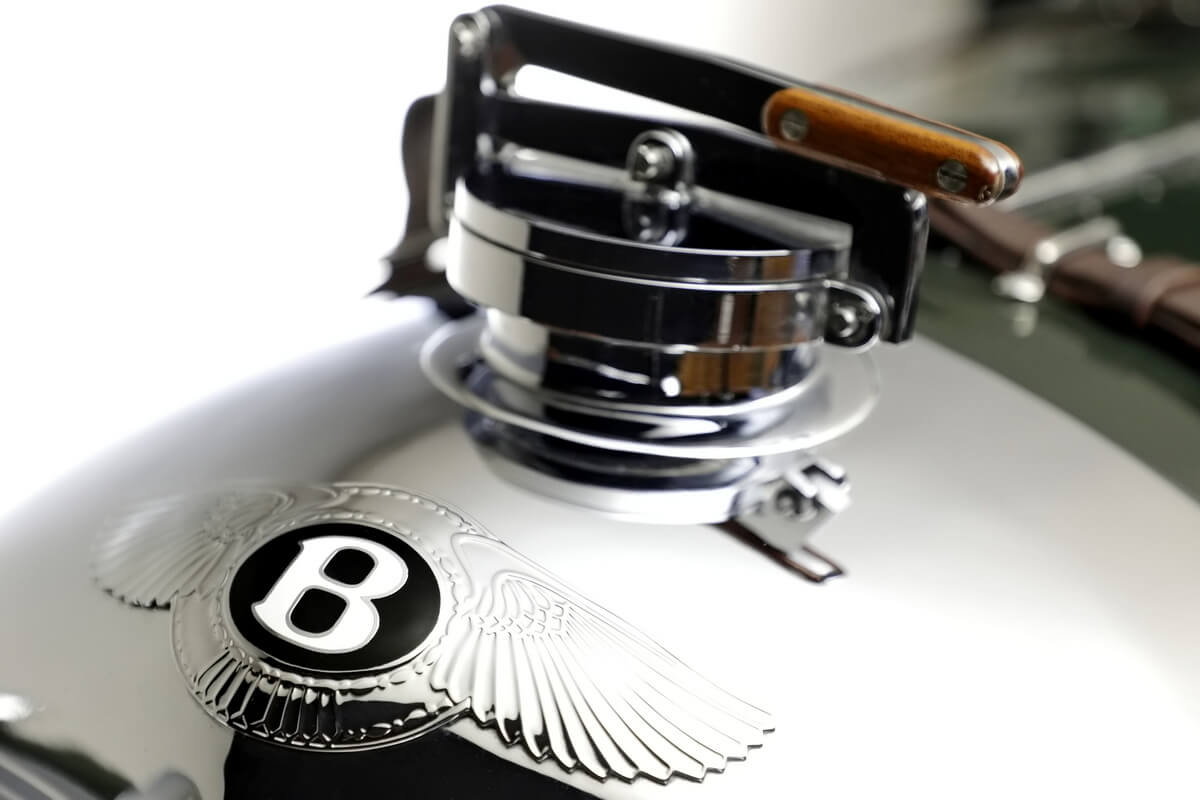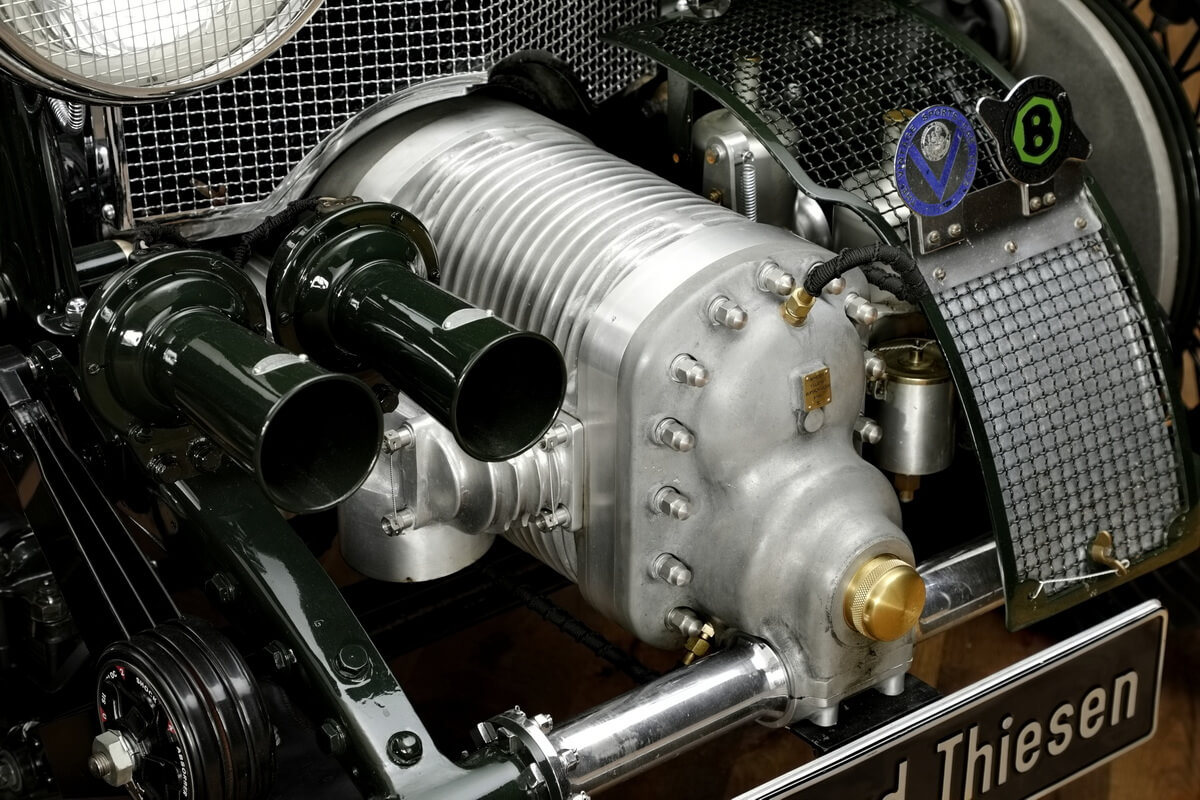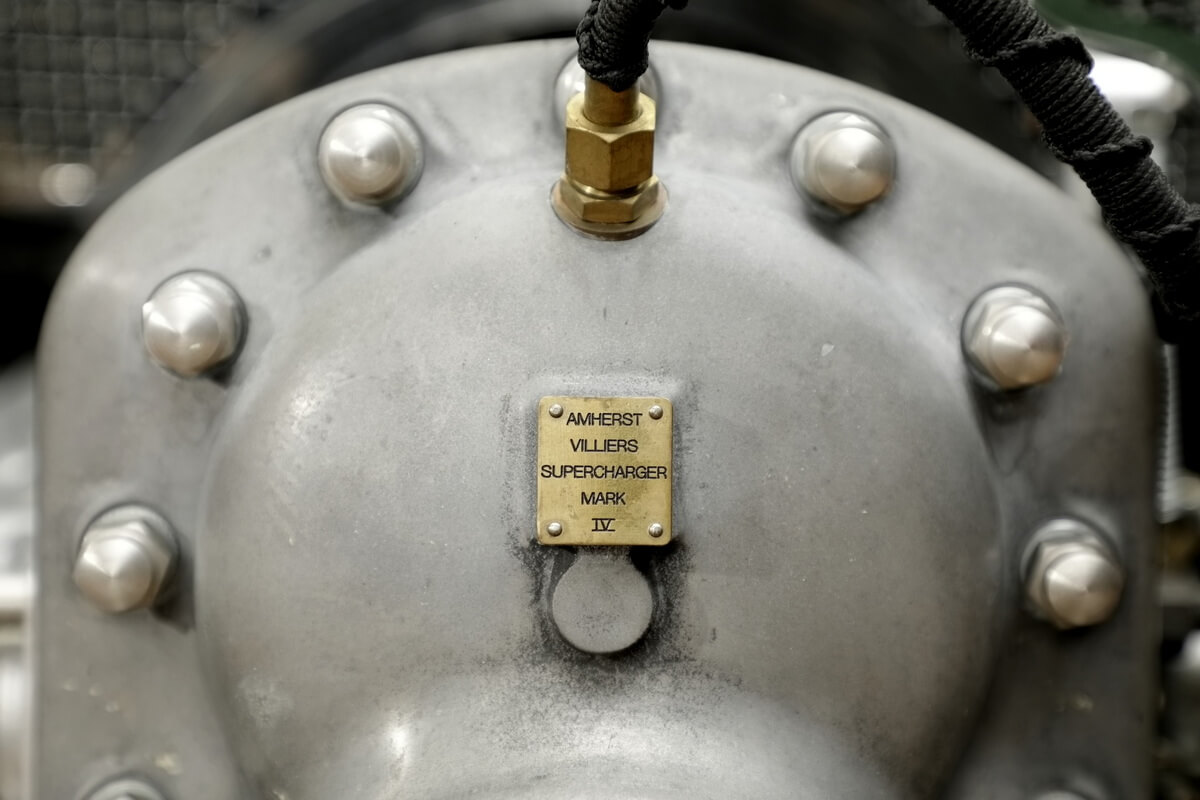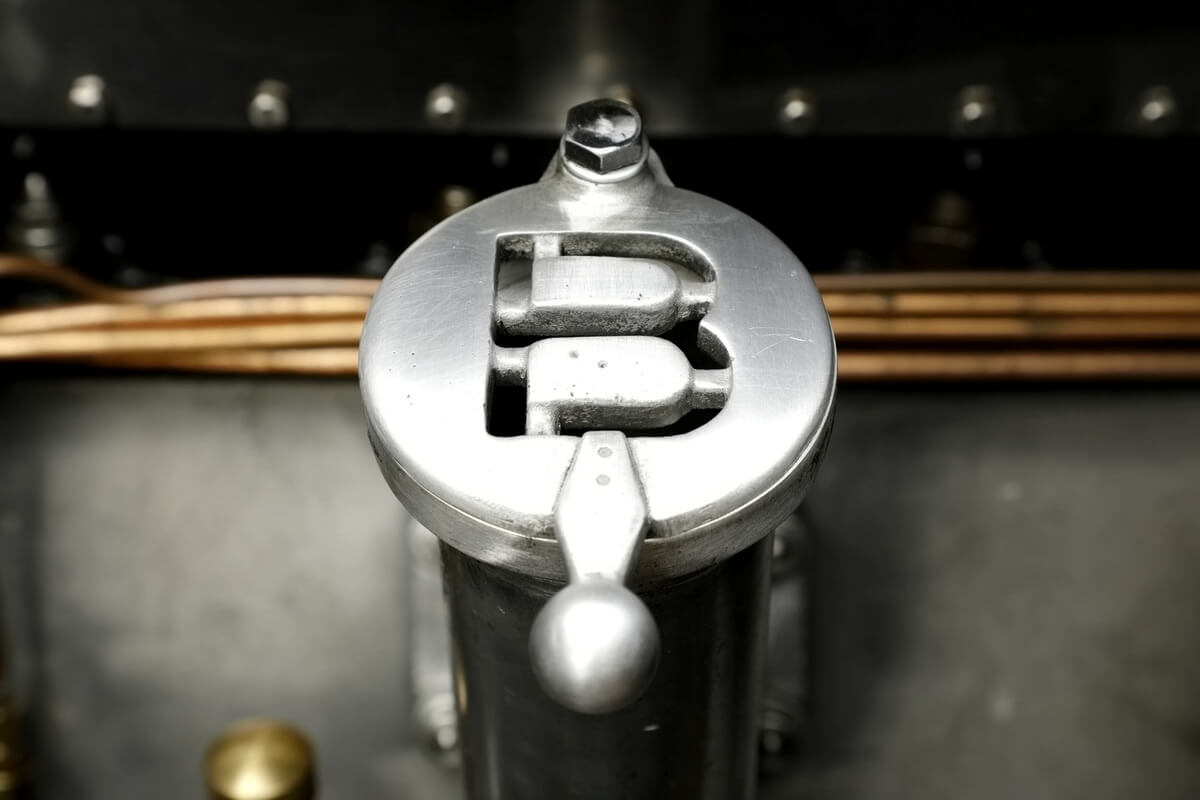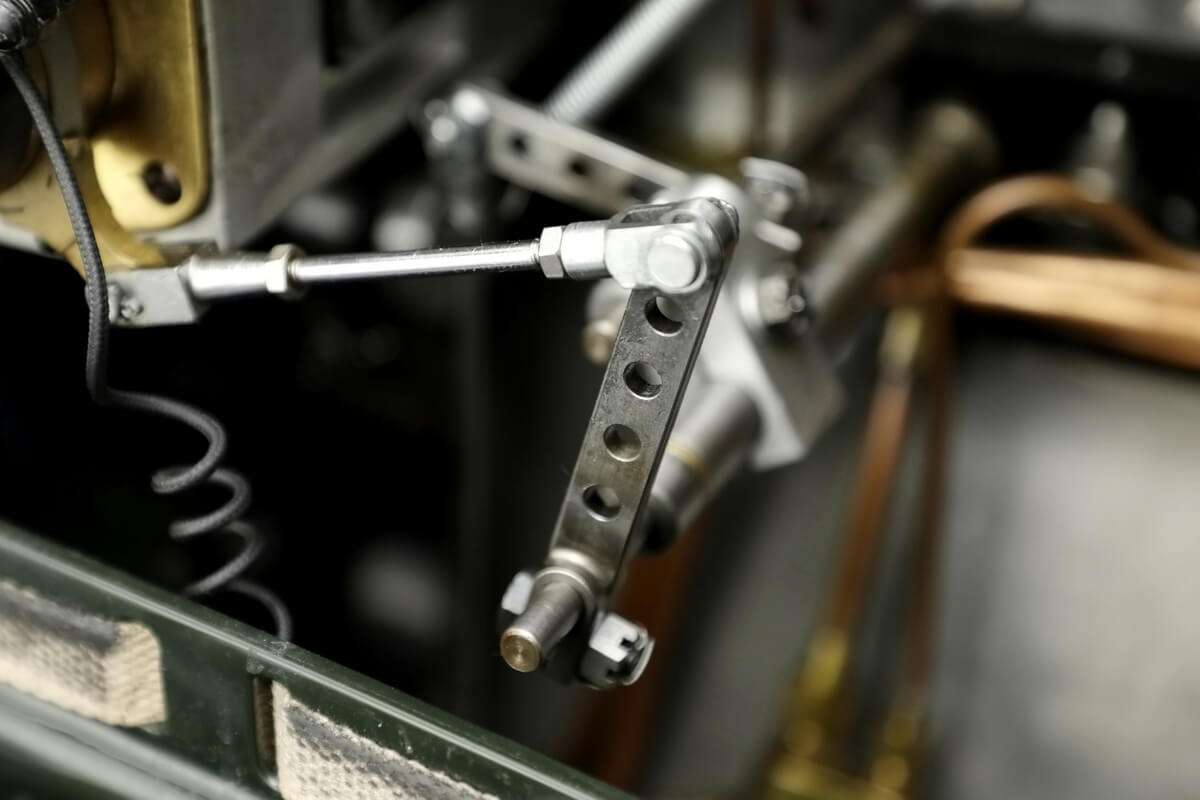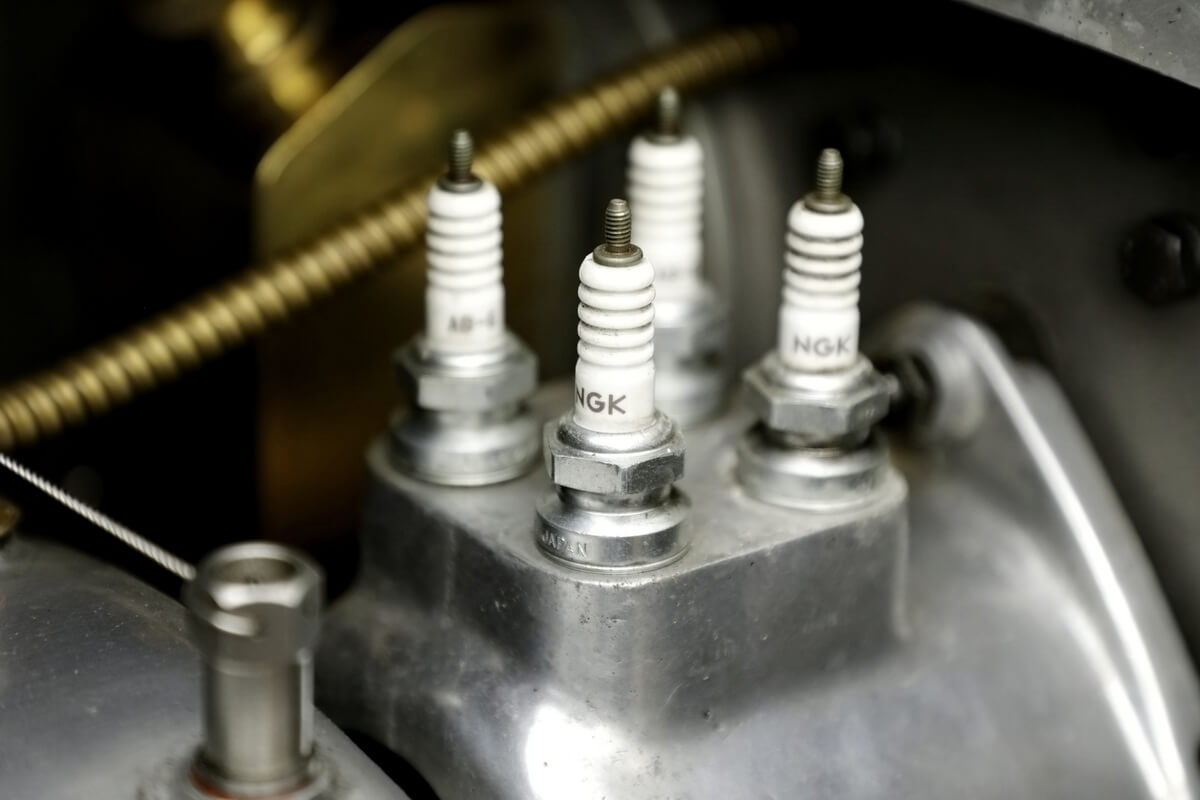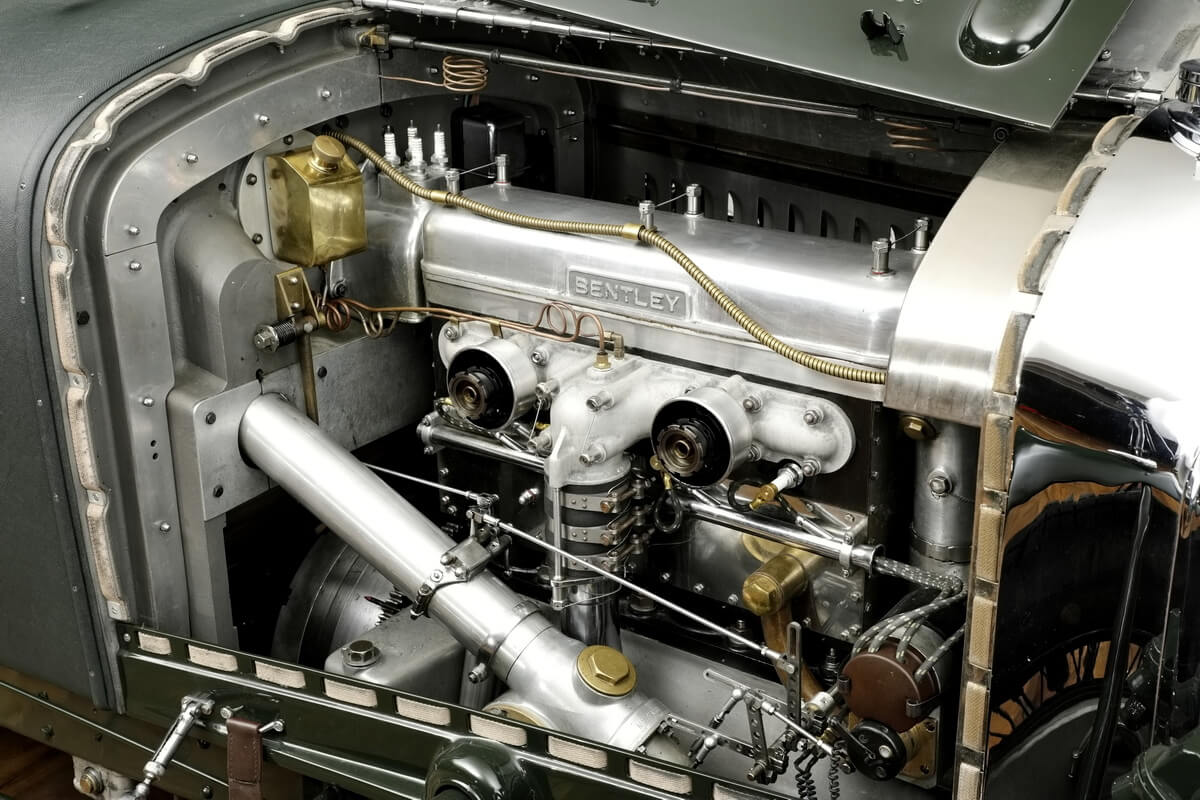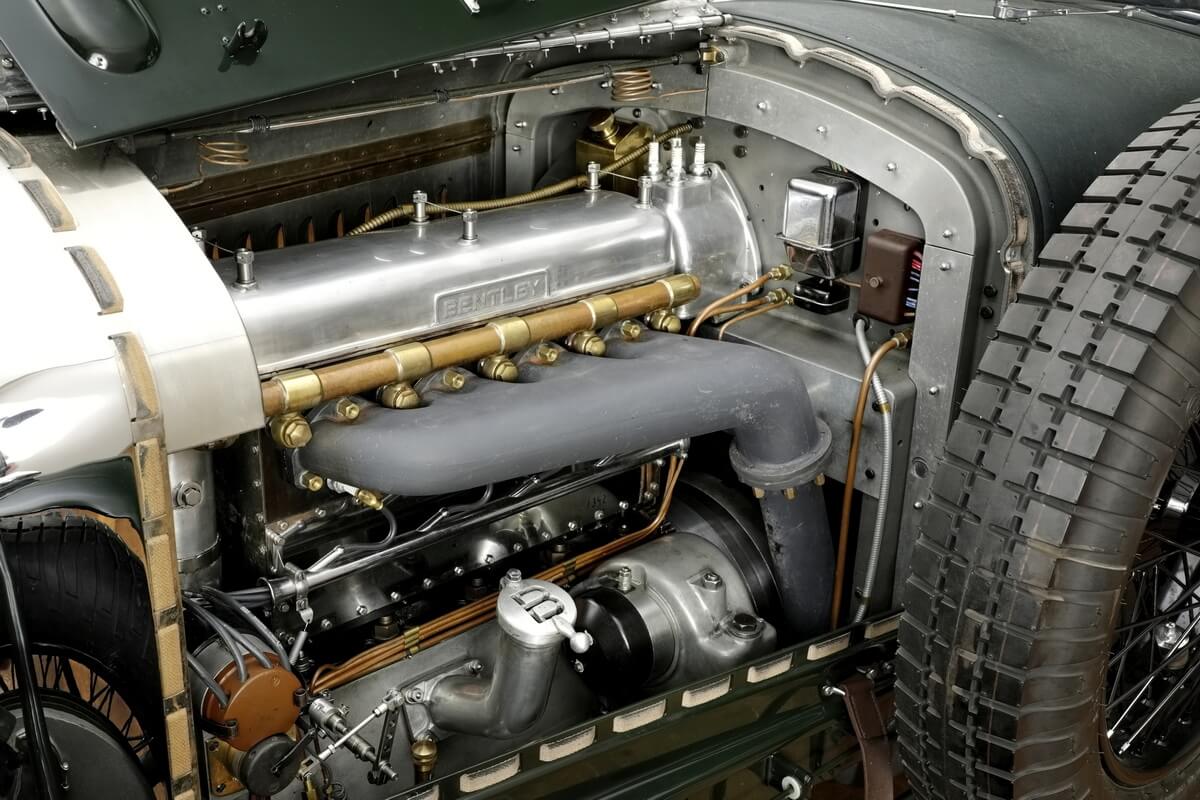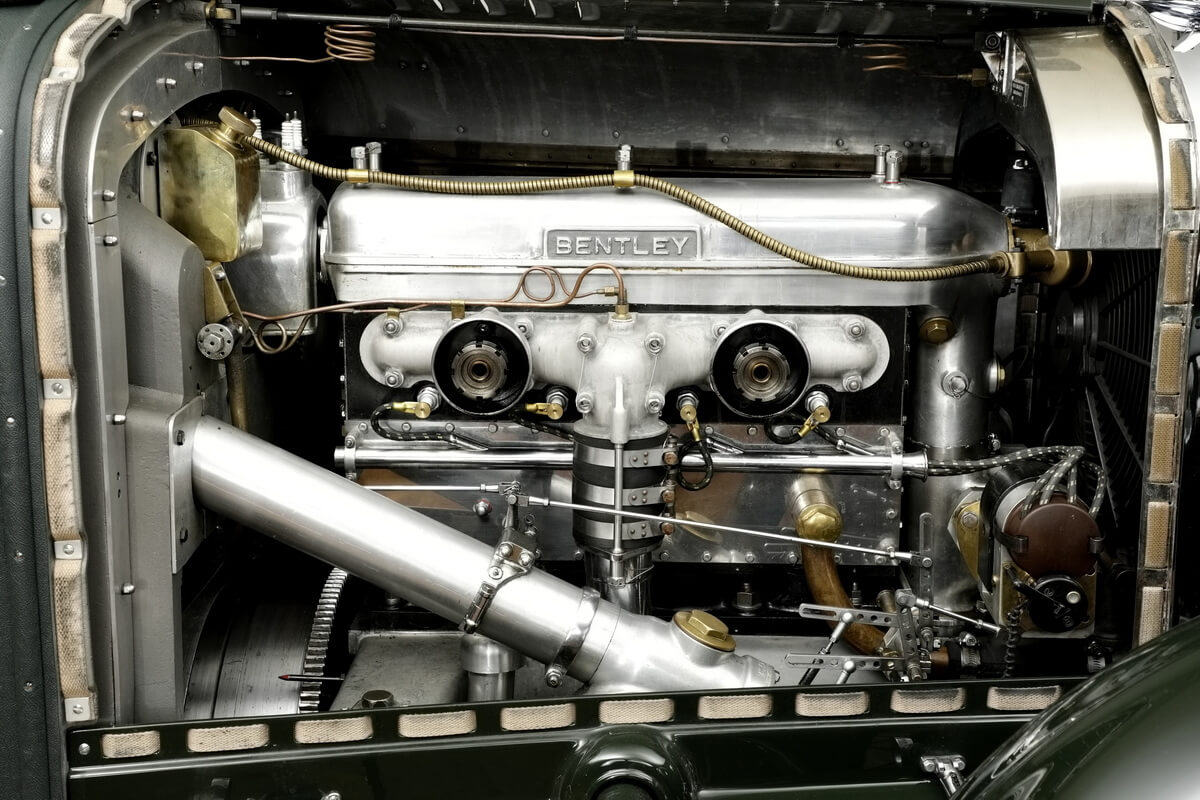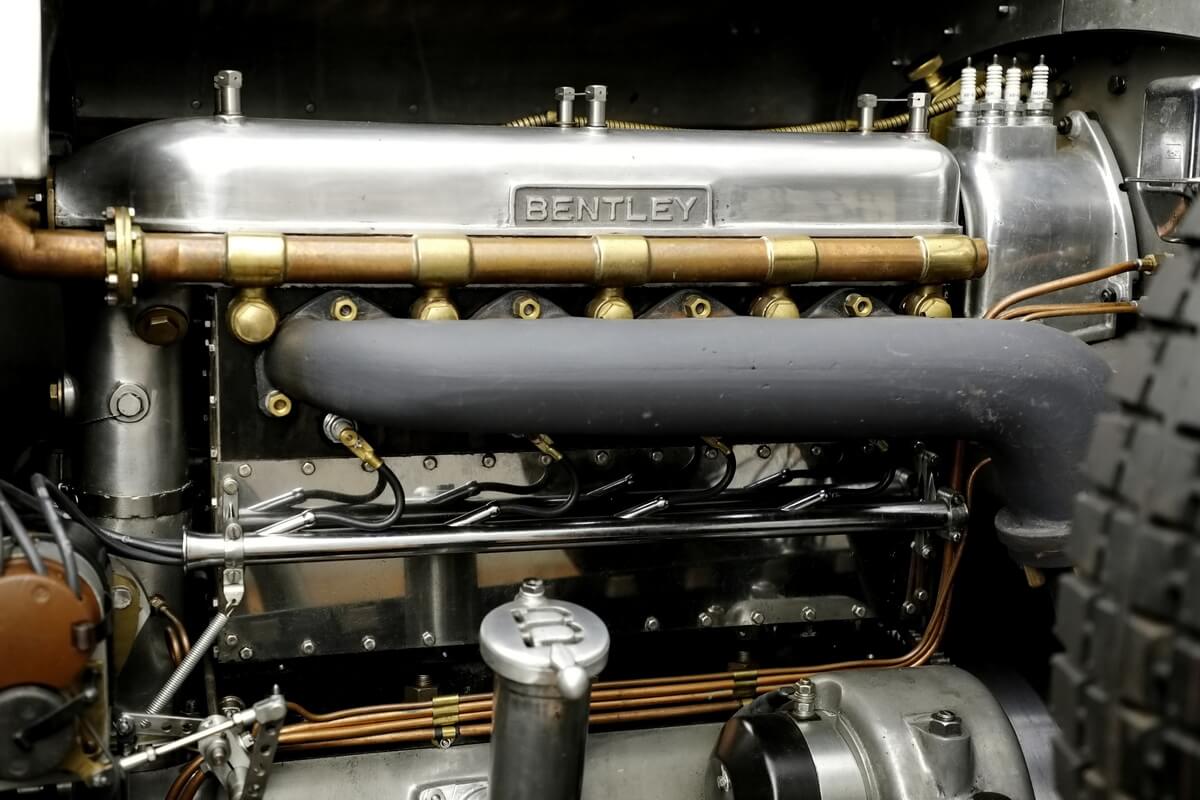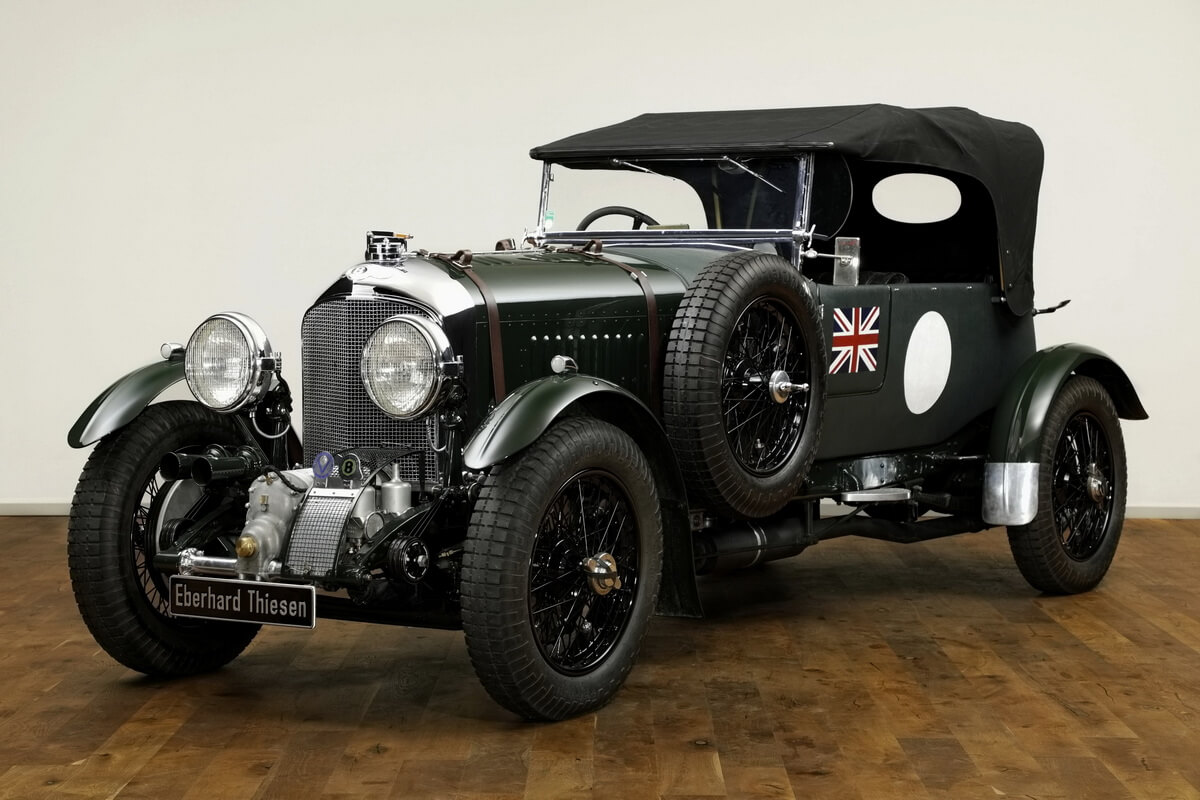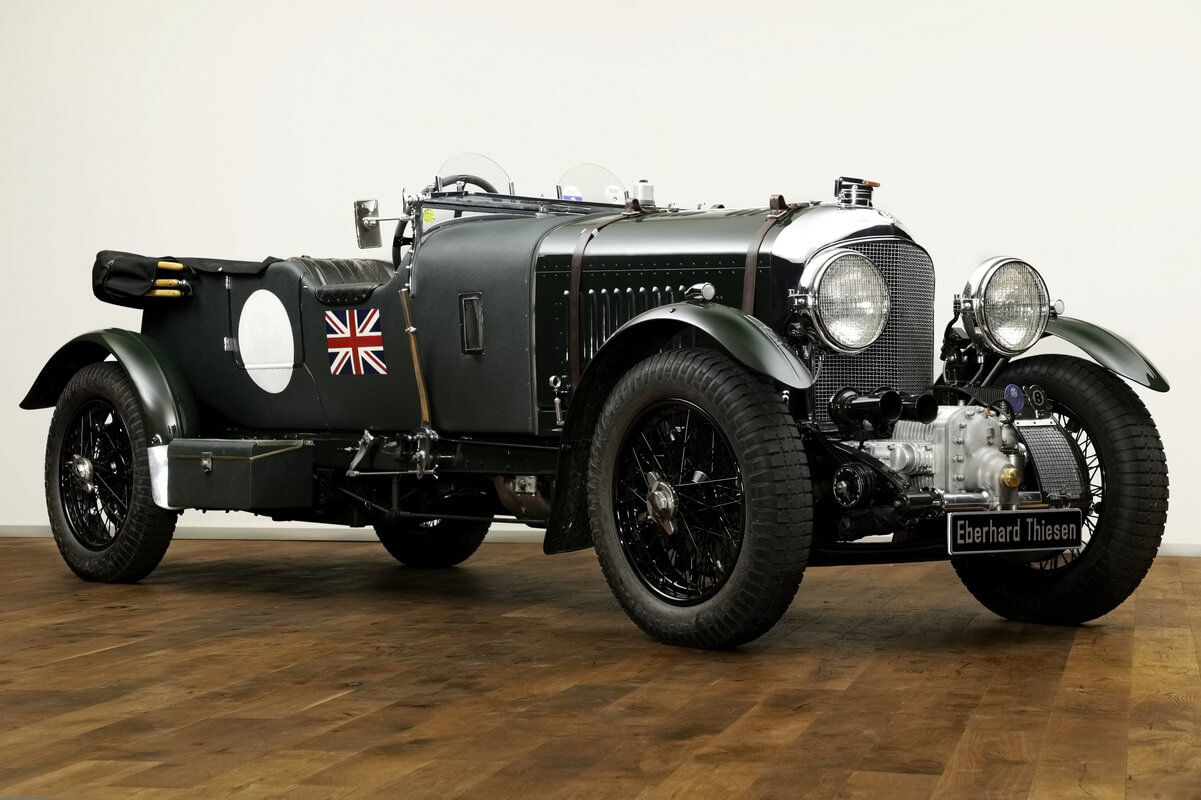Bentley 4.5 Litre Blower Vanden Plas Tourer Le Mans Style
Highlights
Daten & Fakten
Dieses Fahrzeug
Die 4½-Liter Kompressor-Bentleys aus der Zeit von 1929 bis 1931 – allgemein auch als „Blower“ bezeichnet – gehören zu den legendärsten frühen Modellen der Marke. Sie stammen aus der Epoche, als Bentley-Automobile im Rennsport sehr erfolgreich waren und 1924, 1927, 1928, 1929 und 1930 die 24 Stunden von Le Mans gewonnen hatten. Zu der Zeit war Bentley noch unter der technischen Regie von Gründer W.O. Bentley aber schon unter der Führung von Woolf Barnato. Ein finanzstarker Investor, Lebemann und Rennfahrer, der zu der illustren Gruppe der so genannten „Bentley-Boys“ gehörte. Die Idee zur Kompressor-Aufladung des 4½ Liter Modells stammte im Jahr 1929 von Sir Henry "Tim" Birkin, einem weiteren „Bentley Boy“ und Rennfahrer.
Dieser Bentley 4½ Liter „Blower“ gehört zu den nur 50 werksseitigen Kompressor-Modellen, die von Bentley für die Renn-Homologation nach Le Mans Spezifikation für den Kundenverkauf gefertigt wurden. Weitere fünf 4½ Liter Kompressor-Fahrzeuge gingen direkt an Tim Birkin für geplante Renn-Einsätze. Das Chassis ist ein Standard-Kompressor Fahrgestell aus der zweiten Serie von 25 Chassis (MS 3926-3950) mit einem gerippten Kompressor-Gehäuse. Es wurde laut vorliegender Dokumentation nach seinem letzten Test bei Bentley Motors in Cricklewood am 9. September 1931 mit einer offenen viersitzigen „Sport“-Karosserie des Karosseriebauers Mayfair in der Lackierung schwarz mit grau gesprenkeltem Leder ausgestattet. Dieser Wagen ist laut Bentley Drivers Club wohl das einzige Kompressor-Exemplar, das eine Mayfair-Karosserie erhielt.
Er wurde dann im November vom Bentley Händler Jack Barclay Ltd. in London (diesen Händler gibt es noch heute) übernommen. Laut Kaufvertrag vom 13. November 1931 wurde der Wagen an Alexander & Garner in Manchester zu einem Preis von 1.075 GBP verkauft. Die Zulassung erfolgte am 16. November auf das Kennzeichen „GT 8771“, das den Wagen sein Leben lang begleiten wird. Die Käufer fungierten aber wohl nur als Intermediär und der Wagen ging sodann an seinen ersten Besitzer, J. R. Quayle aus Blackpool. Dieser war der Bürgermeister der Stadt und besaß bereits ein früheres 3-Liter Modell von 1924. Für diesen späten Blower-Bentley existiert ein Werks-Serviceprotokoll mit technischen Spezifikationen, das fortlaufend Einträge bis 1939 enthält.
Im Jahr 1935 gelangte der Bentley in den Besitz von H. St. M. de Trafford aus Haselor Hall, Tamworth, Staffordshire, der den Wagen während des Zweiten Weltkriegs und bis 1951 besaß. Zu dieser Zeitpunkt war der Wagen noch mit seiner ursprünglichen Mayfair-Karosserie versehen, wie historische Fotografien aus der Zeit zeigen. Der nachfolgende Eigentümer war E.O. Hamblen-Thomas, der den Bentley bis 1956 besaß. Darauf folgte Ian S. Burge als vierter Besitzer bis zum Jahr 1960. Er ließ den Wagen mit einer originalen viersitzigen Vanden Plas Sportkarosserie mit Stoffbespannung (auf Basis eines Holzkörpers) und zugehörigen Helm-Kotflügeln versehen, die von einem anderen Bentley 4½ Litre Chassis ohne Kompressor stammte. Die genaue Herkunft ist nicht verifizierbar und bezieht sich auf den hinteren Karosserieteil für die Passagiere. Die Motorhaube ist laut vorhandener Nummern bis heute das Original der ersten Mayfair-Karosserie.
Im Oktober 1960 wurde dieser Bentley in seiner „neuen“ Form von Carl B. Seaman in Columbus, Ohio (USA), erworben. Er ließ den Wagen restaurieren und insbesondere die Vanden Plas Karosserie von 1961 bis 1963 neu aufbauen, wobei 80% des Eschenholzrahmens erneuert sowie eine neue Stoff-Außenhaut und neues Leder auf der Innenseite aufgetragen wurden. Im Jahr 1972 kehrte der Wagen nach Großbritannien zurück und hatte fortan fünf weitere Eigentümer bis 1995, deren Namen und jeweiliger Besitz-Zeitraum alle bekannt und dokumentiert sind.
Mitte der 1980er Jahre erfolgte eine umfassende Restaurierung bei dem bekannten Bentley-Spezialisten Dick Moss. Dabei wurde der Holzrahmen der Karosserie erneut überarbeitet. Im Anschluss 1985 gewann der Bentley den ersten Platz in seiner Klasse beim Concours des Bentley Drivers Club in den Kensington Gardens. Im Jahr 1995 gelangte der Wagen über eine Auktion in Pebble Beach zum vorletzten Eigentümer in Großbritannien, der ihm 17 Jahre lang die Treue hielt.
Seit 2012 ist dieser Bentley bei seinem aktuellen Besitzer in Deutschland, der ihn seitdem intensiv auf zahlreichen Events und Rallyes nutze. Er ließ den Wagen seit dem Erwerb in seiner Beschaffenheit und hinsichtlich Originalität untersuchen einschließlich Materialanalysen. Bei einem anerkannten Fachbetrieb für klassische Automobile erfolgte in mehreren Schritten eine umfassende Restaurierung mit der Überholung technischer und mechanischer Komponenten, der Installation eines neuen Motors und Kompressors sowie dem Anfertigen einer neuen Karosserie analog dem bisherigen Design als Vanden Plas Open Tourer Le Mans Style.
Die Karosserie-Erneuerung erfolgte mit Hilfe erfahrener Holztechnik-Spezialisten. Sie fertigten einen neuen Holzrahmen, der auf dem Chassis-Rahmen montiert wurde. Im Anschluss wurde der Holzrahmen mit dem originalgetreuen Bezug Rexin von „The Vintage Fabric Company“ neu bespannt. Diese Marke wurde 2015 von Clare Hay und R.C. Moss revitalisiert und fertigt mit den Arbeitsmethoden und Maschinen der 1920/30er Jahre die damaligen Spezialbezüge für Fahrzeugkarosserien. Zudem wurde auch die Aluminiumbeplankung erneuert. In Abweichung zum vorherigen Karosserie-Design ist auf der linken Seite nur eine Tür (statt zwei) vorhanden.
Für den Antrieb sind aktuell ein neuer Motor nach entsprechenden Spezifikationen und ein neuer Kompressor mit SU HO8-Vergasern von Neil Davis installiert. Der Motor ist mit einer gerippten 4-Gallonen-Ölwanne in sog. Birkin-Ausführung mit Entlüftung ausgestattet. Der originale Motor wurde von Bentley früher komplett neu aufgebaut. Er verfügt über ein Ersatzkurbelgehäuse und eine Ersatzölwanne, da beides durch eine gebrochene Pleuelstange beschädigt wurden. Dieser zuvor montierte Motor ist zusammen mit dem originalen Kompressor und Anlasser („Matching Numbers“) auf einer separaten Standvorrichtung montiert und gehört zum Lieferumfang des Fahrzeugs. Das originale Kurbelgehäuse der Auslieferung ist vorhanden und gehört ebenfalls zum Lieferumfang des Wagens.
Das komplett originale Rolling Chassis von 1931 umfasst neben dem Fahrgestell das „D-Type“ Getriebe, die Vorder- und Hinterachse, das Lenkgetriebe sowie zudem auch die Motorhaube und Schalttafel, die alle mit der entsprechenden Nummer gestempelt sind.
Wie viele Fahrzeuge dieser Art und Epoche hat auch dieser Bentley eine bewegte Geschichte mit diversen Besitzern, Erneuerungen und Modifikationen erlebt. Umso wichtiger ist jedoch eine umfassende und lückenlose Dokumentation der Historie. Dieser Bentley hat sie – mit vielen Details, Fotos und Grafiken sowie aktuellem Status ist sie in einem 200-seitigen Buch zusammengefasst. Dazu gehört ein Bericht von der anerkannten Bentley-Expertin Dr. Clare Hay.
Dieser Bentley 4½ Litre als seltener echter „Blower“ unterscheidet sich von den vielen Komplett-Recreations im Markt durch seinen hohen Grad an Originalität und seine bekannte Historie. Die exzellente Restaurierung nach höchsten Standards sorgt für zuverlässige Performance und Funktionalität – perfekt für hohe Fahrbarkeit und ein ultimatives „Bentley Boy“ Erlebnis.
Modellgeschichte
Der Bentley 4½ Litre kam 1927 auf den Markt und trat die Nachfolge des 3 Litre Models an. Von Bentley wurden wie damals üblich nur die Rolling Chassis (Fahrgestell mit Motor und Getriebe) angeboten und mit Aufbauten verschiedener Karosseriebauer versehen, darunter Vanden Plas, Mayfair, Mulliner und Park Ward. Der Motor des 4½ Litre wurde technisch vom 6½ Litre Sechszylinder abgeleitet, indem man zwei Zylinder entfernte. So entstand ein Reihen-Vierzylinder mit 4.398 ccm Hubraum, der mit vier Ventilen pro Zylinder sehr fortschrittlich konstruiert war. Er galt als sehr zuverlässig und belastbar, was eine wichtige Grundlage für die motorsportlichen Erfolge von Bentley war. Mit Siegen auf den wichtigsten Rennstrecken wie 1928 und 1929 beim 24-Stunden-Rennen von Le Mans förderte der 4½ Litre die Popularität und den Verkauf der Marke.
Ab 1929 war zudem ein leistungsgesteigertes Modell mit Kompressor erhältlich, das als „Blower“ bekannt wurde. Diese Variante geht zurück auf den Rennfahrer Sir Henry „Tim“ Birkin, einen der legendären „Bentley Boys“, der einen größeren Motor mit mehr Hubraum wegen des höheren Gewichts ablehnte. Stattdessen erwog er den Einsatz der damals neuen Kompressortechnik, wie Mercedes Benz sie im Rennsport erfolgreich verwendete. In Eigenregie und finanziert durch Sponsor Dorothy Paget baute er Anfang 1929 sein eigenes 4½ Litre Modell mit einem Roots-Kompressor um. Diese Idee wurde von W.O. Bentley nicht unterstützt, denn er folgte dem Prinzip: „Hubraum ist durch nichts zu ersetzen. Außer durch mehr Hubraum.“
Trotzdem erhielt Birkin vom damaligen Firmen-Chef Woolf Barnato – auch ein „Bentley Boy“ – fünf 4½ Litre Modelle mit Kompressor, den Amherst Villiers entwickelt hatte. Für die Rennsport-Homologation in Le Mans wurden 50 weitere „Blower“-Fahrzeuge gefertigt. Die Birkin-Teamfahrzeuge und auch die Werks-Bentley mit Kompressor waren die leistungsstärksten britischen Sportwagen, die in Le Mans und Brooklands antraten. Durch den Einbau dieses Kompressors stieg die Leistung des 4.398 ccm großen Triebwerks von 110 auf 175 PS und als Top-Speed wurden rund 200 km/h erreicht.
Der Verkauf der Kompressor-Straßenfahrzeuge war jedoch alles andere als ein Erfolg: der Verbrauch war deutlich zu hoch. Zudem blieben größere Rennerfolge des „Blower“ aus. Außer der schnellsten Rennrunde bei den 24-Stunden von Le Mans 1930 und einem zweiten Platz beim Grand Prix von Frankreich in Pau im gleichen Jahr konnten sie nicht viel erreichen. So musste der Preis für die Straßenmodelle schließlich von ursprünglich 1.475 auf 1.150 GBP gesenkt werden, um die Bestände abzubauen. Heute gehören die 50 „Blower“ Werks-Bentley hingegen mit zu den extrem gesuchten und begehrten Vorkriegs-Sammlerfahrzeugen.
Dieses Fahrzeug
Die 4½-Liter Kompressor-Bentleys aus der Zeit von 1929 bis 1931 – allgemein auch als „Blower“ bezeichnet – gehören zu den legendärsten frühen Modellen der Marke. Sie stammen aus der Epoche, als Bentley-Automobile im Rennsport sehr erfolgreich waren und 1924, 1927, 1928, 1929 und 1930 die 24 Stunden von Le Mans gewonnen hatten. Zu der Zeit war Bentley noch unter der technischen Regie von Gründer W.O. Bentley aber schon unter der Führung von Woolf Barnato. Ein finanzstarker Investor, Lebemann und Rennfahrer, der zu der illustren Gruppe der so genannten „Bentley-Boys“ gehörte. Die Idee zur Kompressor-Aufladung des 4½ Liter Modells stammte im Jahr 1929 von Sir Henry "Tim" Birkin, einem weiteren „Bentley Boy“ und Rennfahrer.
Dieser Bentley 4½ Liter „Blower“ gehört zu den nur 50 werksseitigen Kompressor-Modellen, die von Bentley für die Renn-Homologation nach Le Mans Spezifikation für den Kundenverkauf gefertigt wurden. Weitere fünf 4½ Liter Kompressor-Fahrzeuge gingen direkt an Tim Birkin für geplante Renn-Einsätze. Das Chassis ist ein Standard-Kompressor Fahrgestell aus der zweiten Serie von 25 Chassis (MS 3926-3950) mit einem gerippten Kompressor-Gehäuse. Es wurde laut vorliegender Dokumentation nach seinem letzten Test bei Bentley Motors in Cricklewood am 9. September 1931 mit einer offenen viersitzigen „Sport“-Karosserie des Karosseriebauers Mayfair in der Lackierung schwarz mit grau gesprenkeltem Leder ausgestattet. Dieser Wagen ist laut Bentley Drivers Club wohl das einzige Kompressor-Exemplar, das eine Mayfair-Karosserie erhielt.
Er wurde dann im November vom Bentley Händler Jack Barclay Ltd. in London (diesen Händler gibt es noch heute) übernommen. Laut Kaufvertrag vom 13. November 1931 wurde der Wagen an Alexander & Garner in Manchester zu einem Preis von 1.075 GBP verkauft. Die Zulassung erfolgte am 16. November auf das Kennzeichen „GT 8771“, das den Wagen sein Leben lang begleiten wird. Die Käufer fungierten aber wohl nur als Intermediär und der Wagen ging sodann an seinen ersten Besitzer, J. R. Quayle aus Blackpool. Dieser war der Bürgermeister der Stadt und besaß bereits ein früheres 3-Liter Modell von 1924. Für diesen späten Blower-Bentley existiert ein Werks-Serviceprotokoll mit technischen Spezifikationen, das fortlaufend Einträge bis 1939 enthält.
Im Jahr 1935 gelangte der Bentley in den Besitz von H. St. M. de Trafford aus Haselor Hall, Tamworth, Staffordshire, der den Wagen während des Zweiten Weltkriegs und bis 1951 besaß. Zu dieser Zeitpunkt war der Wagen noch mit seiner ursprünglichen Mayfair-Karosserie versehen, wie historische Fotografien aus der Zeit zeigen. Der nachfolgende Eigentümer war E.O. Hamblen-Thomas, der den Bentley bis 1956 besaß. Darauf folgte Ian S. Burge als vierter Besitzer bis zum Jahr 1960. Er ließ den Wagen mit einer originalen viersitzigen Vanden Plas Sportkarosserie mit Stoffbespannung (auf Basis eines Holzkörpers) und zugehörigen Helm-Kotflügeln versehen, die von einem anderen Bentley 4½ Litre Chassis ohne Kompressor stammte. Die genaue Herkunft ist nicht verifizierbar und bezieht sich auf den hinteren Karosserieteil für die Passagiere. Die Motorhaube ist laut vorhandener Nummern bis heute das Original der ersten Mayfair-Karosserie.
Im Oktober 1960 wurde dieser Bentley in seiner „neuen“ Form von Carl B. Seaman in Columbus, Ohio (USA), erworben. Er ließ den Wagen restaurieren und insbesondere die Vanden Plas Karosserie von 1961 bis 1963 neu aufbauen, wobei 80% des Eschenholzrahmens erneuert sowie eine neue Stoff-Außenhaut und neues Leder auf der Innenseite aufgetragen wurden. Im Jahr 1972 kehrte der Wagen nach Großbritannien zurück und hatte fortan fünf weitere Eigentümer bis 1995, deren Namen und jeweiliger Besitz-Zeitraum alle bekannt und dokumentiert sind.
Mitte der 1980er Jahre erfolgte eine umfassende Restaurierung bei dem bekannten Bentley-Spezialisten Dick Moss. Dabei wurde der Holzrahmen der Karosserie erneut überarbeitet. Im Anschluss 1985 gewann der Bentley den ersten Platz in seiner Klasse beim Concours des Bentley Drivers Club in den Kensington Gardens. Im Jahr 1995 gelangte der Wagen über eine Auktion in Pebble Beach zum vorletzten Eigentümer in Großbritannien, der ihm 17 Jahre lang die Treue hielt.
Seit 2012 ist dieser Bentley bei seinem aktuellen Besitzer in Deutschland, der ihn seitdem intensiv auf zahlreichen Events und Rallyes nutze. Er ließ den Wagen seit dem Erwerb in seiner Beschaffenheit und hinsichtlich Originalität untersuchen einschließlich Materialanalysen. Bei einem anerkannten Fachbetrieb für klassische Automobile erfolgte in mehreren Schritten eine umfassende Restaurierung mit der Überholung technischer und mechanischer Komponenten, der Installation eines neuen Motors und Kompressors sowie dem Anfertigen einer neuen Karosserie analog dem bisherigen Design als Vanden Plas Open Tourer Le Mans Style.
Die Karosserie-Erneuerung erfolgte mit Hilfe erfahrener Holztechnik-Spezialisten. Sie fertigten einen neuen Holzrahmen, der auf dem Chassis-Rahmen montiert wurde. Im Anschluss wurde der Holzrahmen mit dem originalgetreuen Bezug Rexin von „The Vintage Fabric Company“ neu bespannt. Diese Marke wurde 2015 von Clare Hay und R.C. Moss revitalisiert und fertigt mit den Arbeitsmethoden und Maschinen der 1920/30er Jahre die damaligen Spezialbezüge für Fahrzeugkarosserien. Zudem wurde auch die Aluminiumbeplankung erneuert. In Abweichung zum vorherigen Karosserie-Design ist auf der linken Seite nur eine Tür (statt zwei) vorhanden.
Für den Antrieb sind aktuell ein neuer Motor nach entsprechenden Spezifikationen und ein neuer Kompressor mit SU HO8-Vergasern von Neil Davis installiert. Der Motor ist mit einer gerippten 4-Gallonen-Ölwanne in sog. Birkin-Ausführung mit Entlüftung ausgestattet. Der originale Motor wurde von Bentley früher komplett neu aufgebaut. Er verfügt über ein Ersatzkurbelgehäuse und eine Ersatzölwanne, da beides durch eine gebrochene Pleuelstange beschädigt wurden. Dieser zuvor montierte Motor ist zusammen mit dem originalen Kompressor und Anlasser („Matching Numbers“) auf einer separaten Standvorrichtung montiert und gehört zum Lieferumfang des Fahrzeugs. Das originale Kurbelgehäuse der Auslieferung ist vorhanden und gehört ebenfalls zum Lieferumfang des Wagens.
Das komplett originale Rolling Chassis von 1931 umfasst neben dem Fahrgestell das „D-Type“ Getriebe, die Vorder- und Hinterachse, das Lenkgetriebe sowie zudem auch die Motorhaube und Schalttafel, die alle mit der entsprechenden Nummer gestempelt sind.
Wie viele Fahrzeuge dieser Art und Epoche hat auch dieser Bentley eine bewegte Geschichte mit diversen Besitzern, Erneuerungen und Modifikationen erlebt. Umso wichtiger ist jedoch eine umfassende und lückenlose Dokumentation der Historie. Dieser Bentley hat sie – mit vielen Details, Fotos und Grafiken sowie aktuellem Status ist sie in einem 200-seitigen Buch zusammengefasst. Dazu gehört ein Bericht von der anerkannten Bentley-Expertin Dr. Clare Hay.
Dieser Bentley 4½ Litre als seltener echter „Blower“ unterscheidet sich von den vielen Komplett-Recreations im Markt durch seinen hohen Grad an Originalität und seine bekannte Historie. Die exzellente Restaurierung nach höchsten Standards sorgt für zuverlässige Performance und Funktionalität – perfekt für hohe Fahrbarkeit und ein ultimatives „Bentley Boy“ Erlebnis.
Modellgeschichte
Der Bentley 4½ Litre kam 1927 auf den Markt und trat die Nachfolge des 3 Litre Models an. Von Bentley wurden wie damals üblich nur die Rolling Chassis (Fahrgestell mit Motor und Getriebe) angeboten und mit Aufbauten verschiedener Karosseriebauer versehen, darunter Vanden Plas, Mayfair, Mulliner und Park Ward. Der Motor des 4½ Litre wurde technisch vom 6½ Litre Sechszylinder abgeleitet, indem man zwei Zylinder entfernte. So entstand ein Reihen-Vierzylinder mit 4.398 ccm Hubraum, der mit vier Ventilen pro Zylinder sehr fortschrittlich konstruiert war. Er galt als sehr zuverlässig und belastbar, was eine wichtige Grundlage für die motorsportlichen Erfolge von Bentley war. Mit Siegen auf den wichtigsten Rennstrecken wie 1928 und 1929 beim 24-Stunden-Rennen von Le Mans förderte der 4½ Litre die Popularität und den Verkauf der Marke.
Ab 1929 war zudem ein leistungsgesteigertes Modell mit Kompressor erhältlich, das als „Blower“ bekannt wurde. Diese Variante geht zurück auf den Rennfahrer Sir Henry „Tim“ Birkin, einen der legendären „Bentley Boys“, der einen größeren Motor mit mehr Hubraum wegen des höheren Gewichts ablehnte. Stattdessen erwog er den Einsatz der damals neuen Kompressortechnik, wie Mercedes Benz sie im Rennsport erfolgreich verwendete. In Eigenregie und finanziert durch Sponsor Dorothy Paget baute er Anfang 1929 sein eigenes 4½ Litre Modell mit einem Roots-Kompressor um. Diese Idee wurde von W.O. Bentley nicht unterstützt, denn er folgte dem Prinzip: „Hubraum ist durch nichts zu ersetzen. Außer durch mehr Hubraum.“ Trotzdem erhielt Birkin vom damaligen Firmen-Chef Woolf Barnato – auch ein „Bentley Boy“ – fünf 4½ Litre Modelle mit Kompressor, den Amherst Villiers entwickelt hatte. Für die Rennsport-Homologation in Le Mans wurden 50 weitere „Blower“-Fahrzeuge gefertigt. Die Birkin-Teamfahrzeuge und auch die Werks-Bentley mit Kompressor waren die leistungsstärksten britischen Sportwagen, die in Le Mans und Brooklands antraten. Durch den Einbau dieses Kompressors stieg die Leistung des 4.398 ccm großen Triebwerks von 110 auf 175 PS und als Top-Speed wurden rund 200 km/h erreicht.
Der Verkauf der Kompressor-Straßenfahrzeuge war jedoch alles andere als ein Erfolg: der Verbrauch war deutlich zu hoch. Zudem blieben größere Rennerfolge des „Blower“ aus. Außer der schnellsten Rennrunde bei den 24-Stunden von Le Mans 1930 und einem zweiten Platz beim Grand Prix von Frankreich in Pau im gleichen Jahr konnten sie nicht viel erreichen. So musste der Preis für die Straßenmodelle schließlich von ursprünglich 1.475 auf 1.150 GBP gesenkt werden, um die Bestände abzubauen. Heute gehören die 50 „Blower“ Werks-Bentley hingegen mit zu den extrem gesuchten und begehrten Vorkriegs-Sammlerfahrzeugen.
